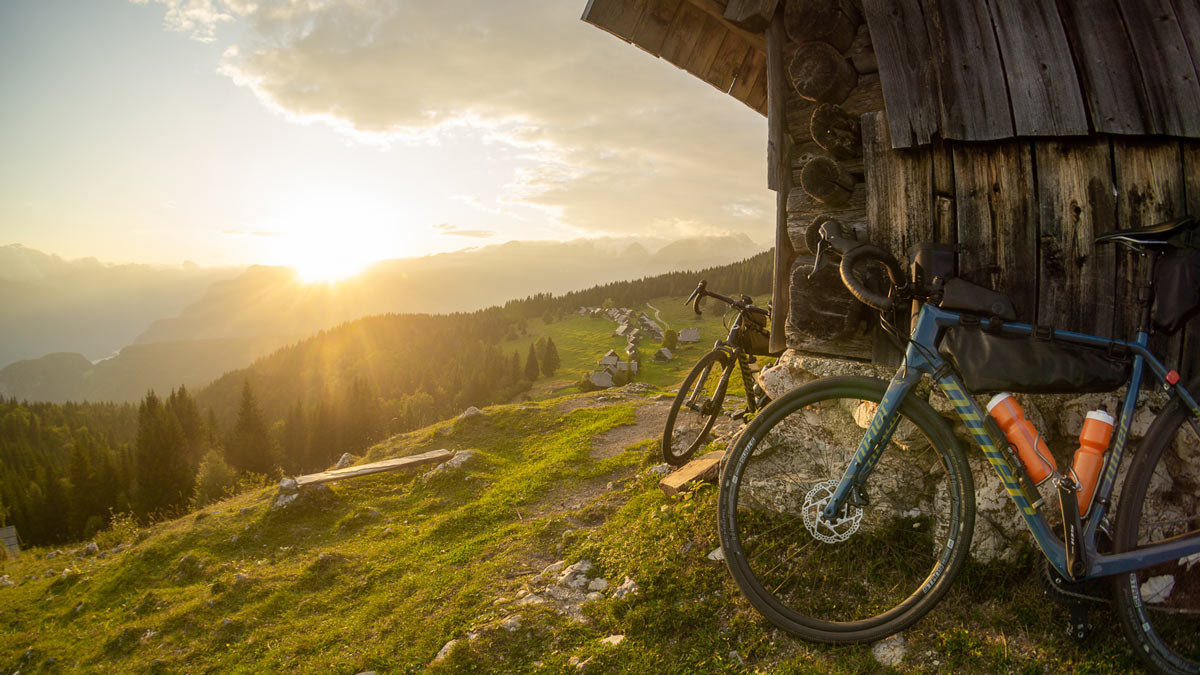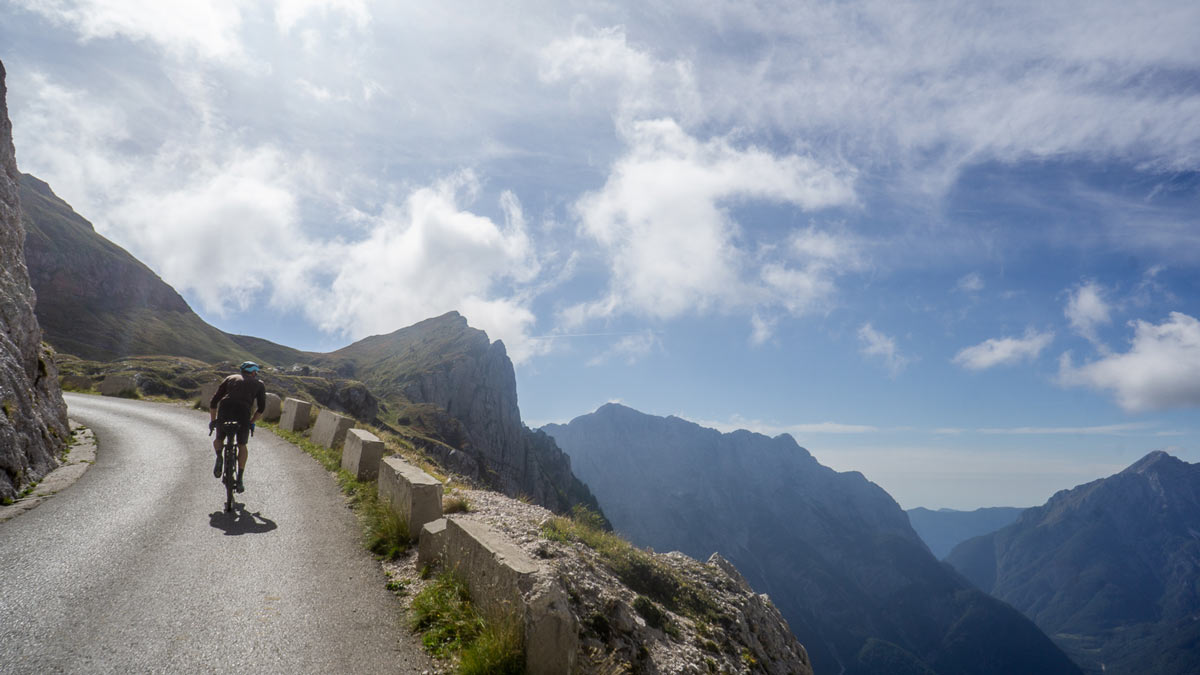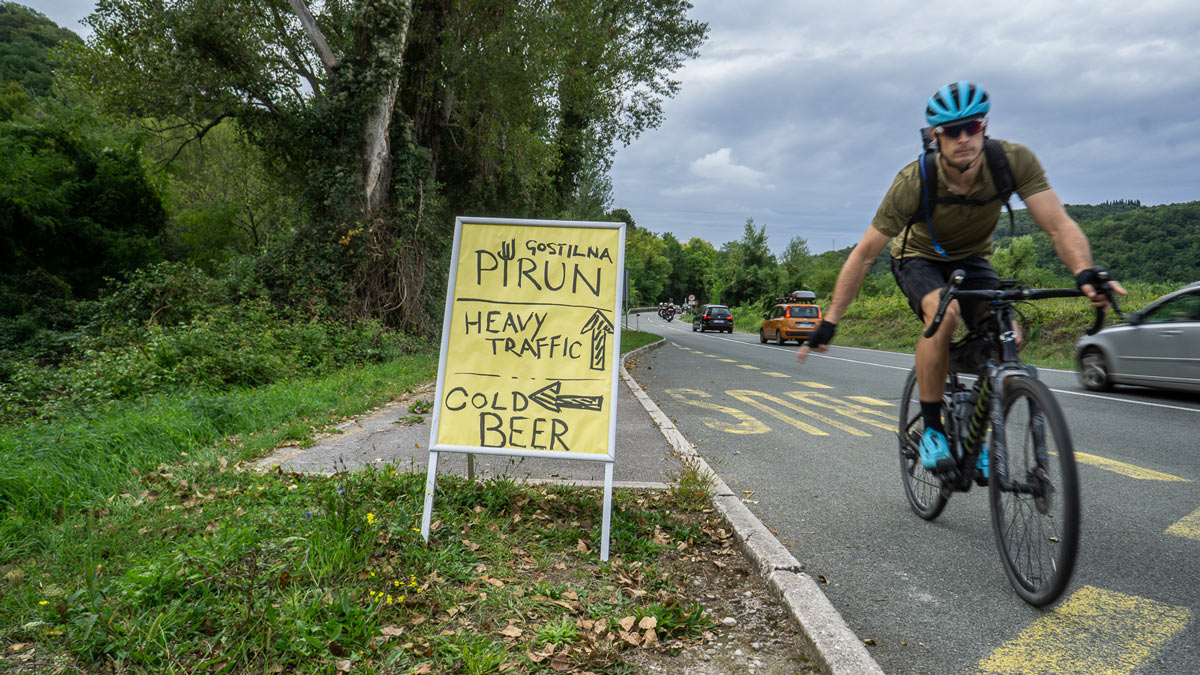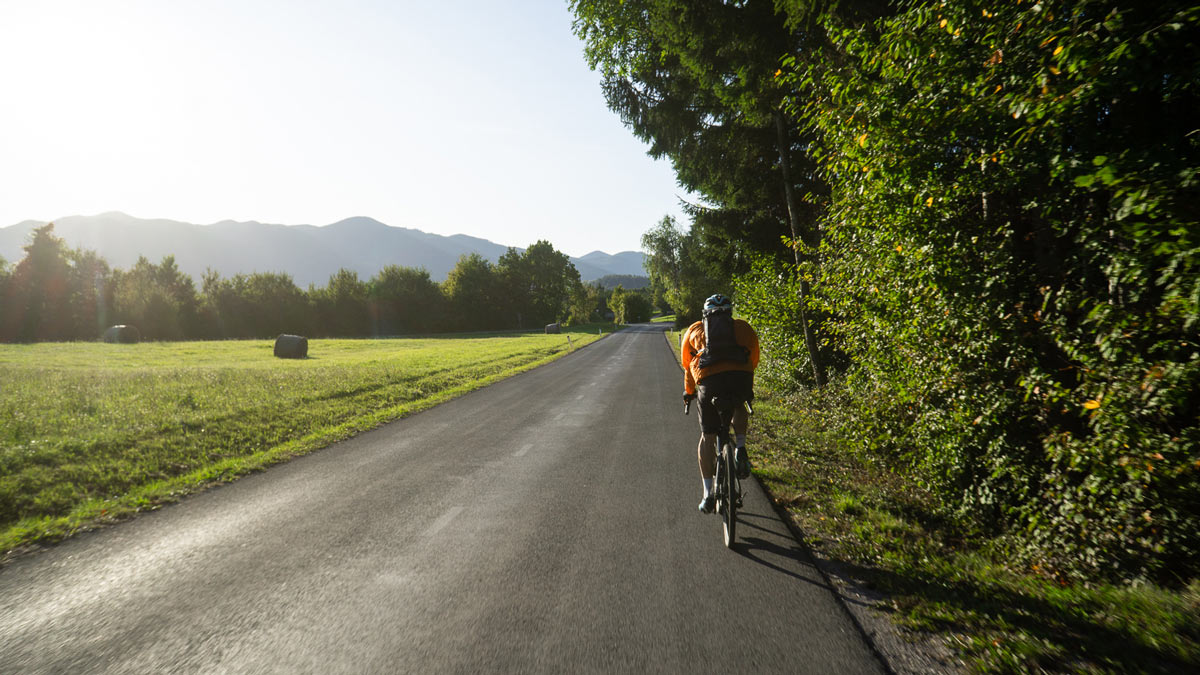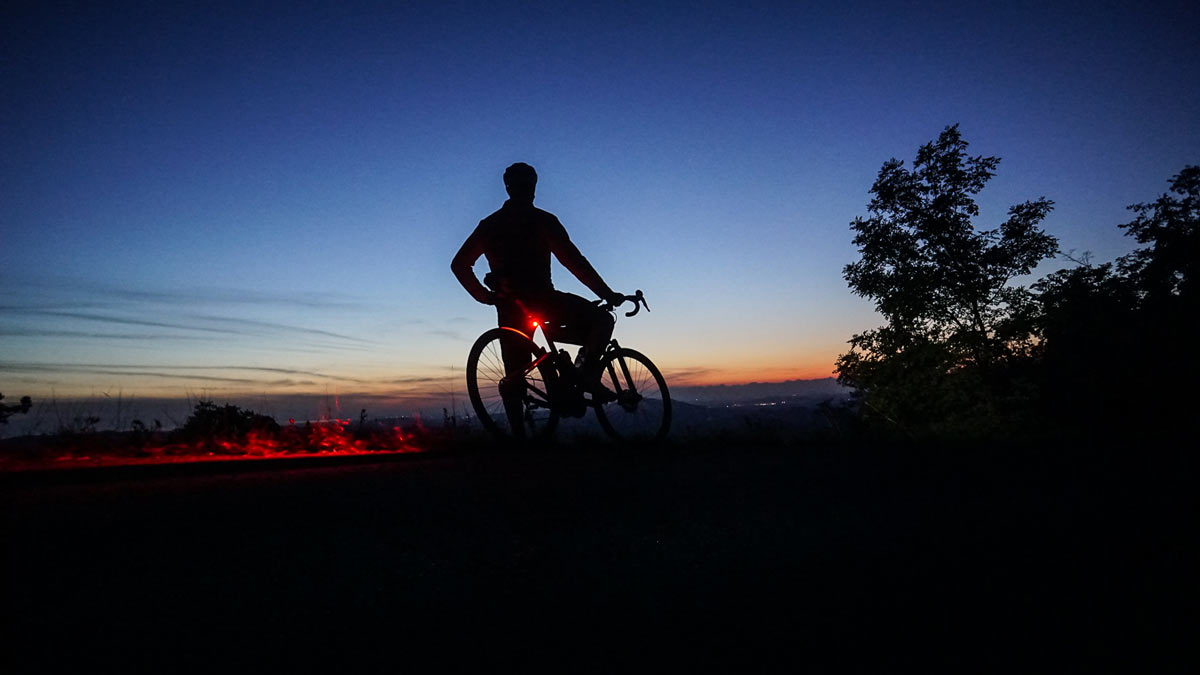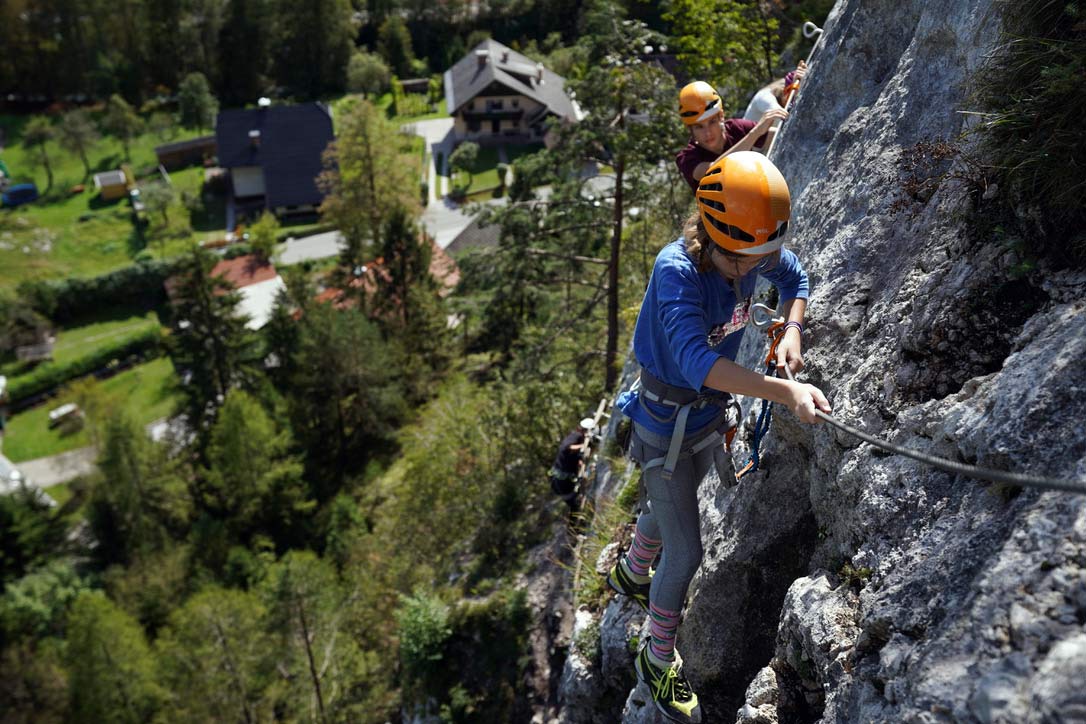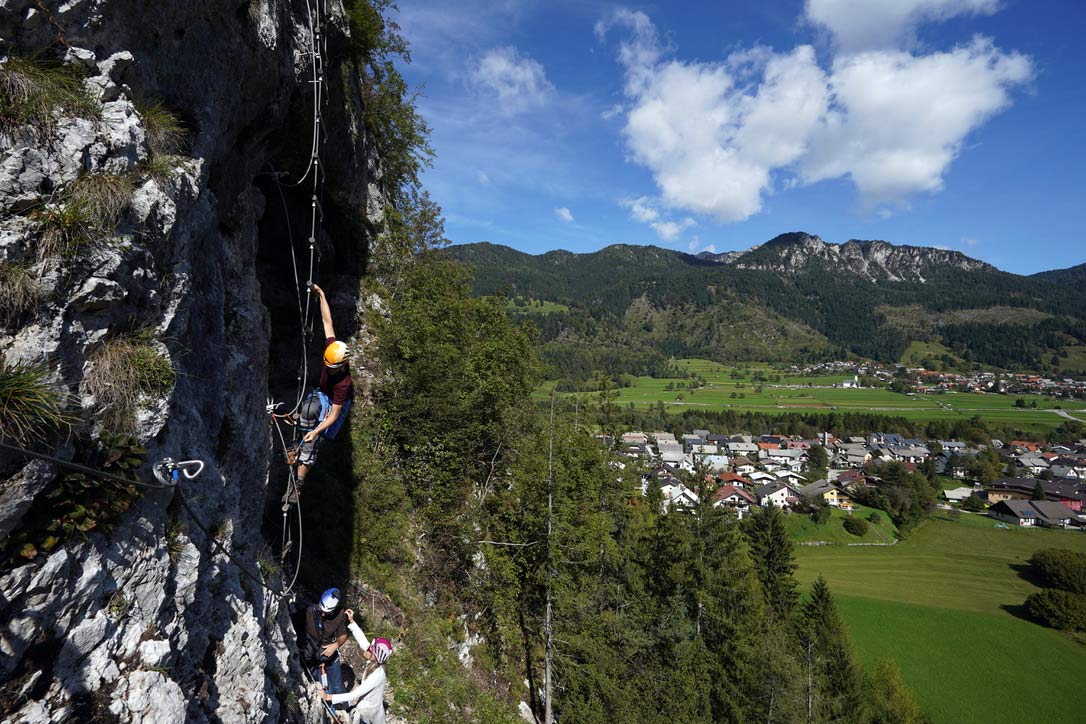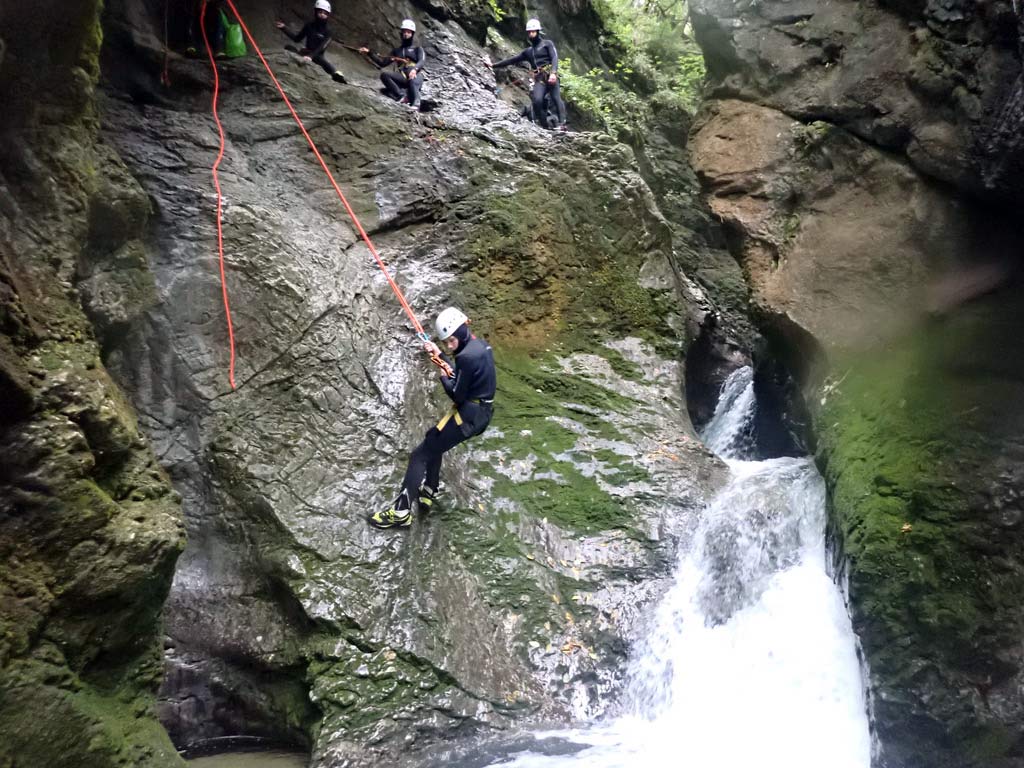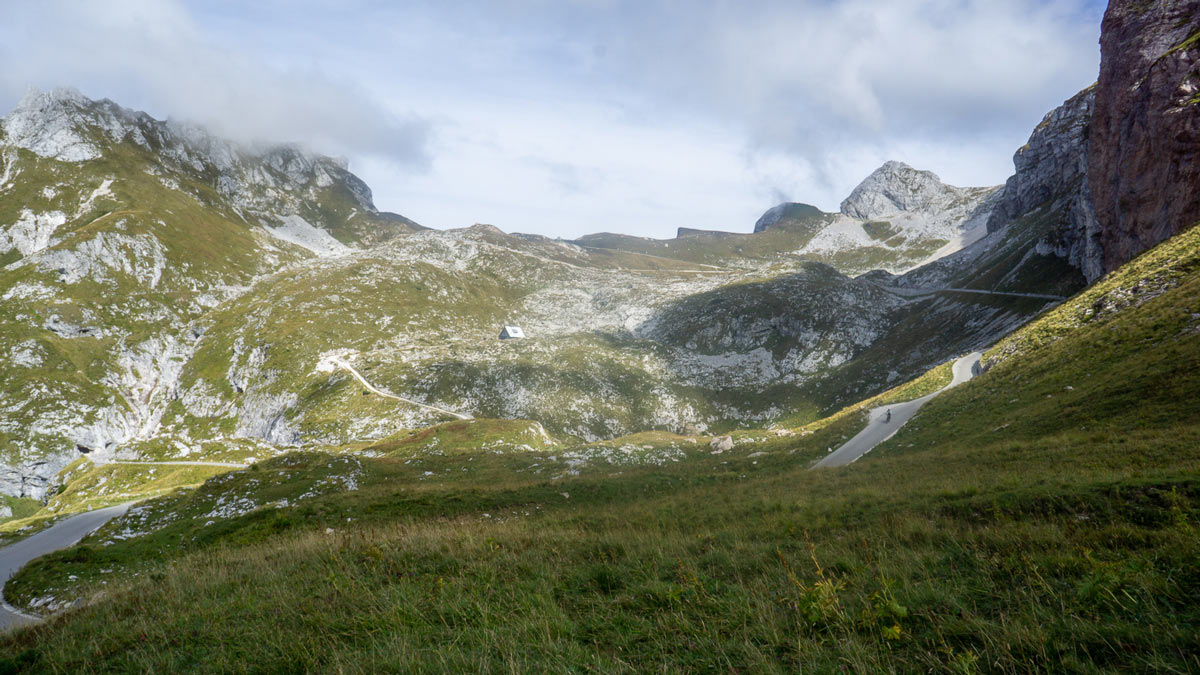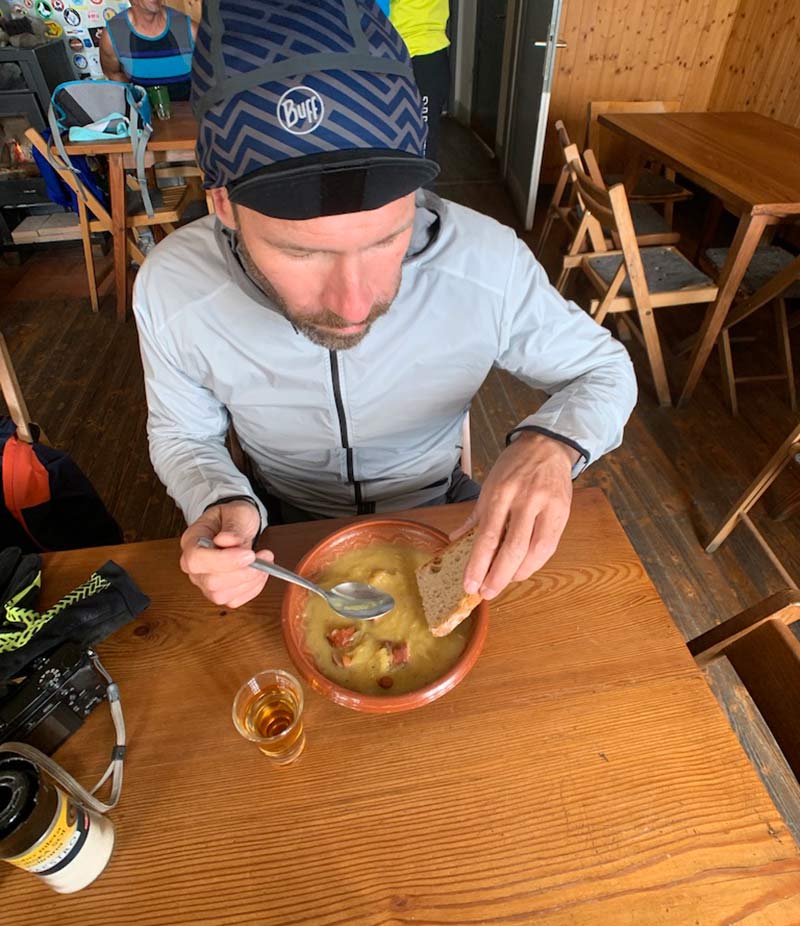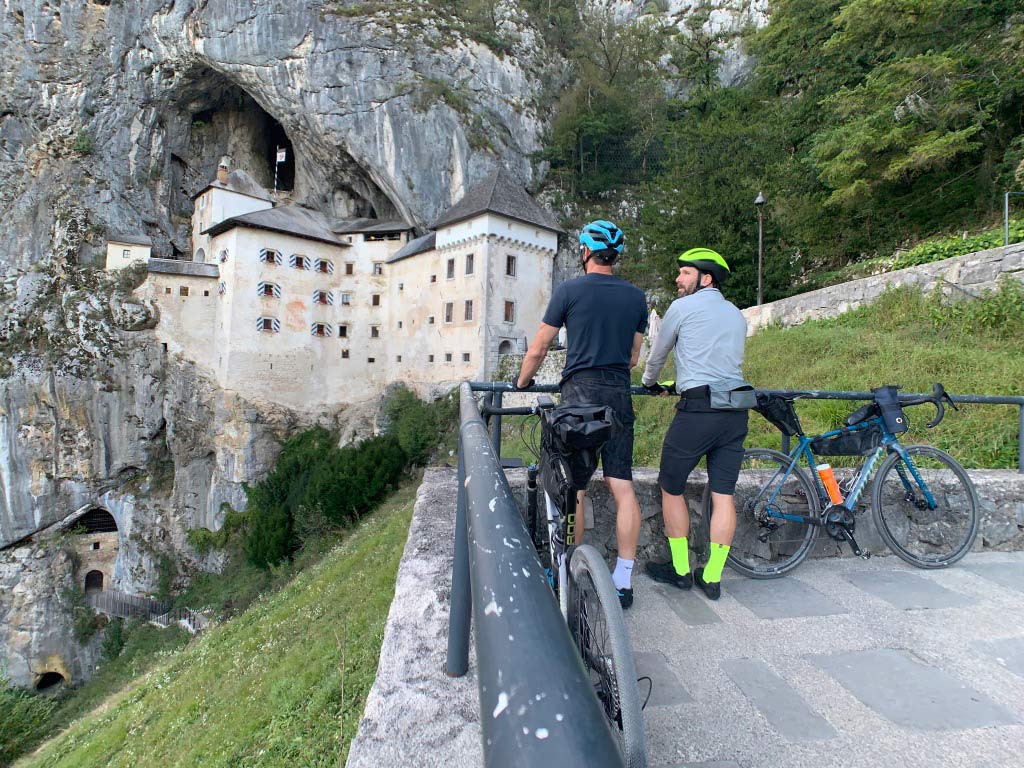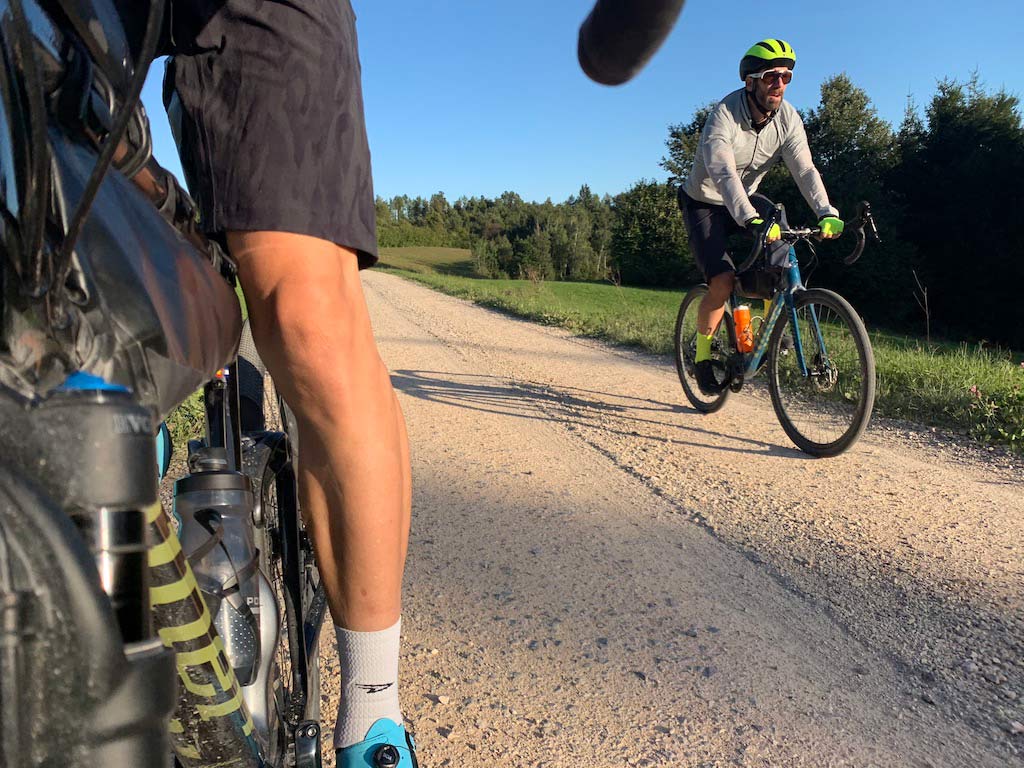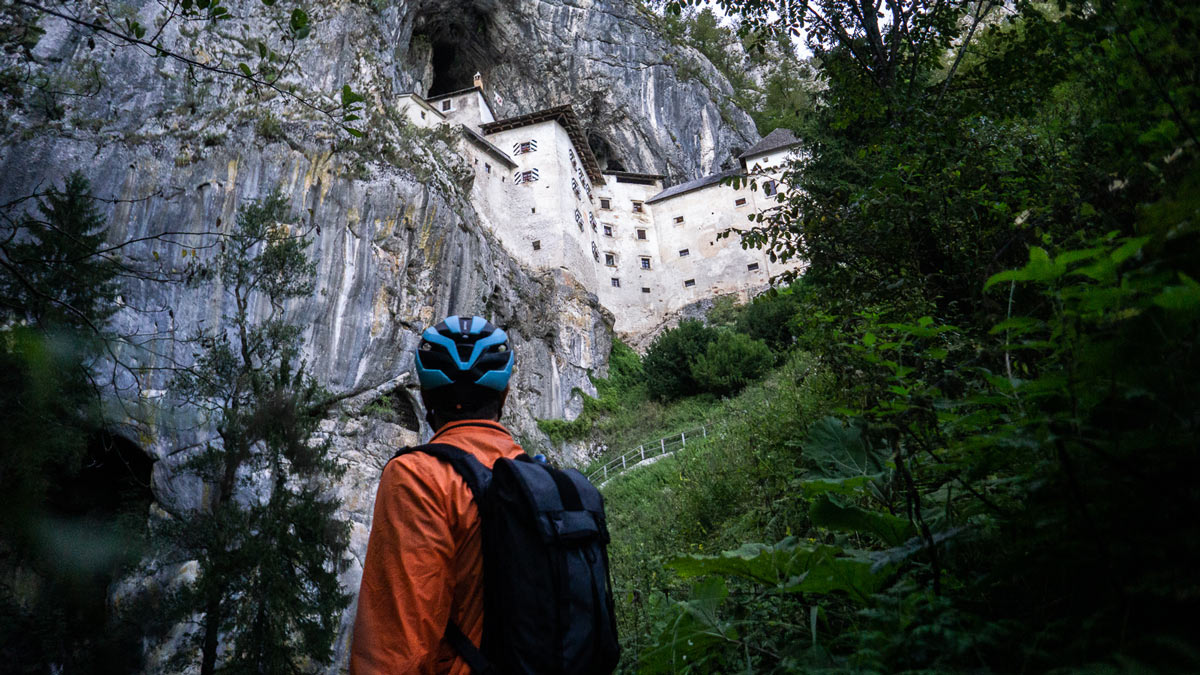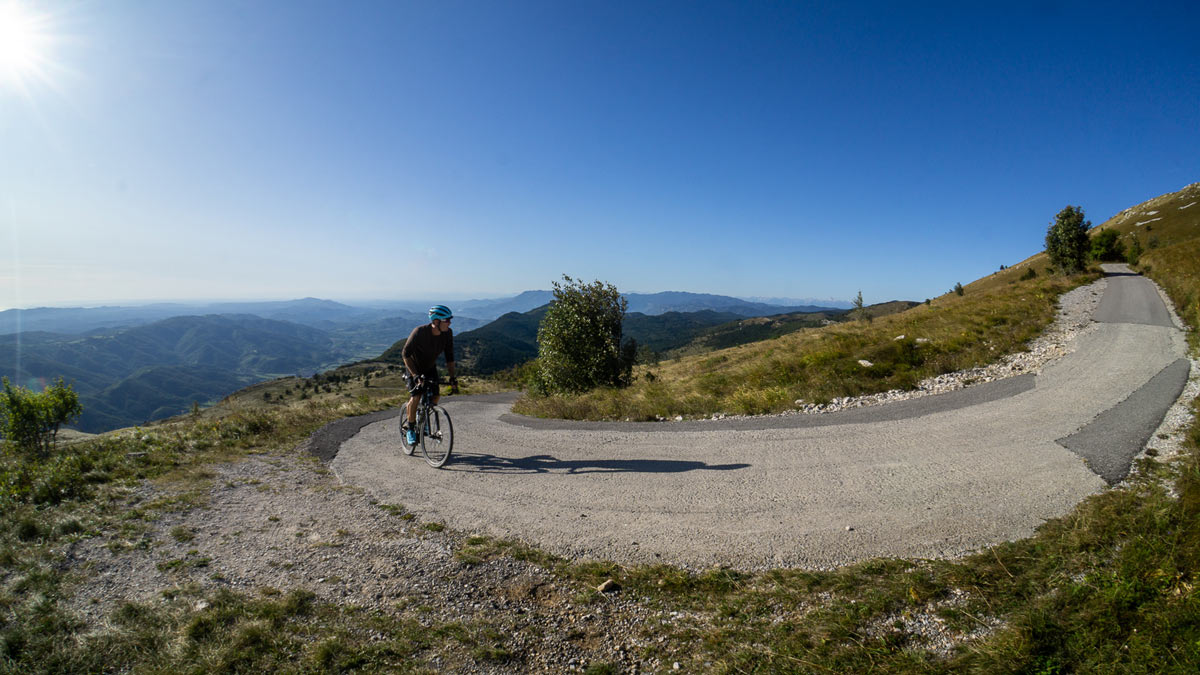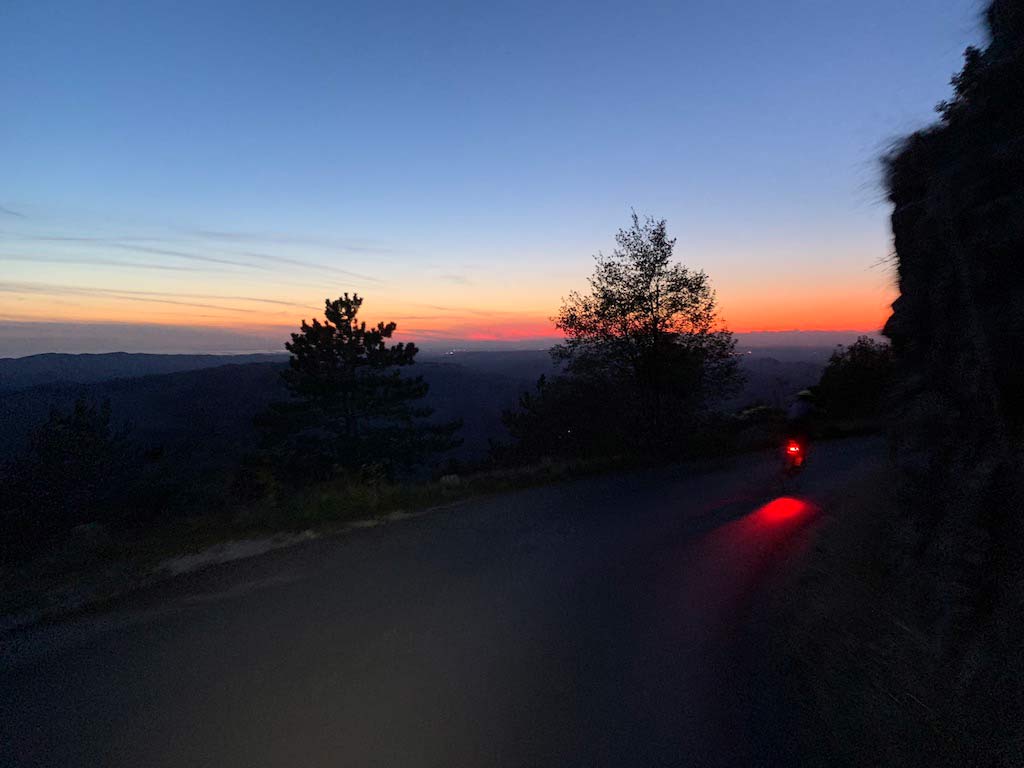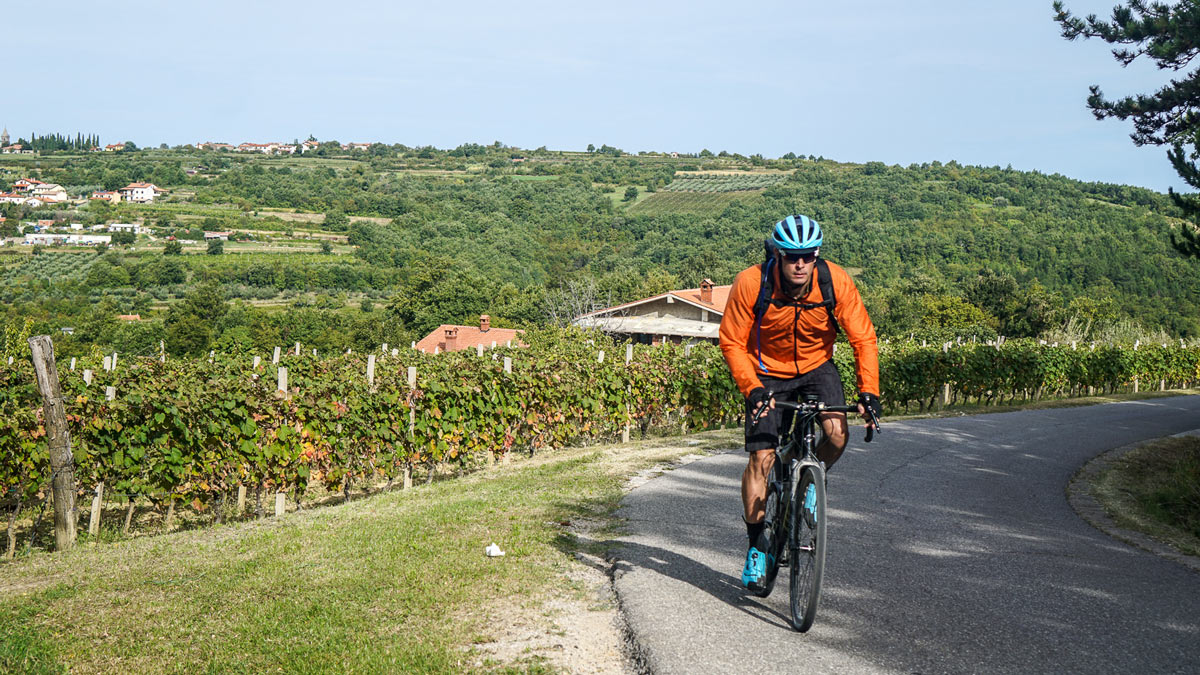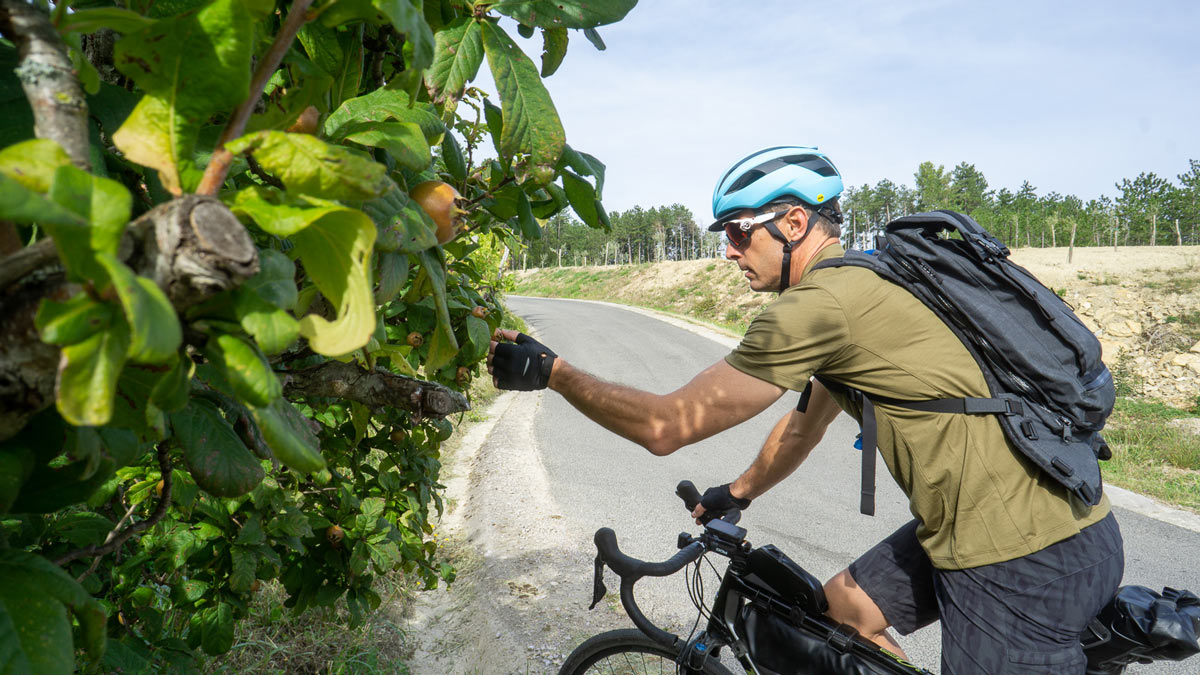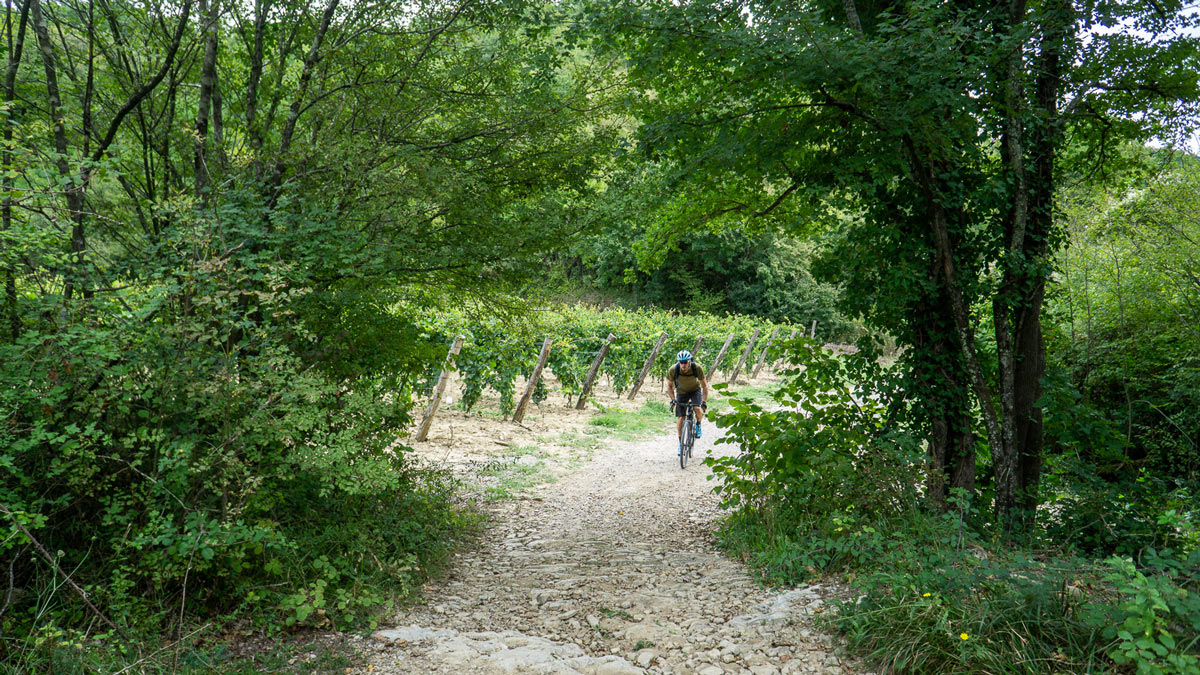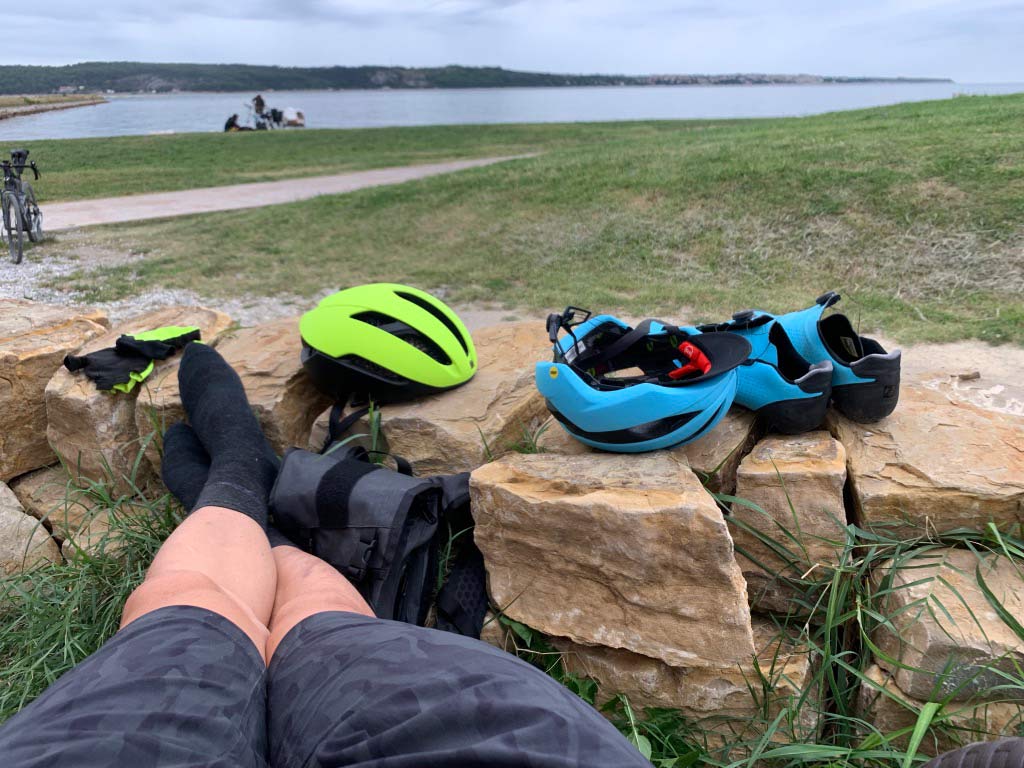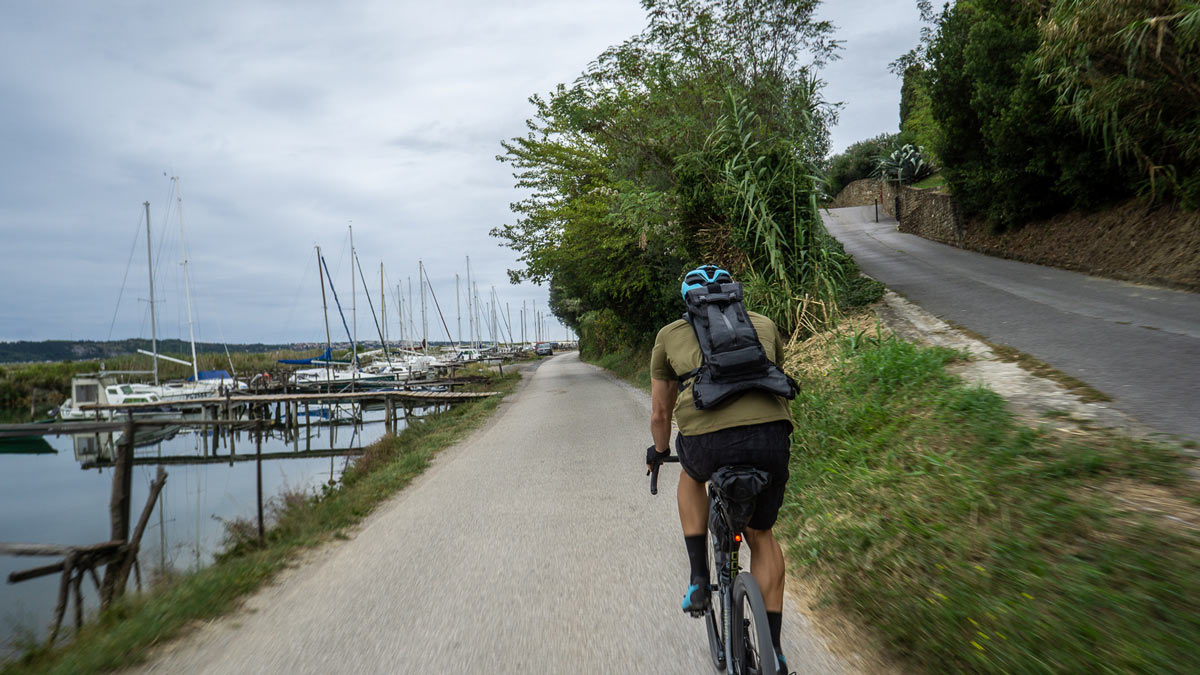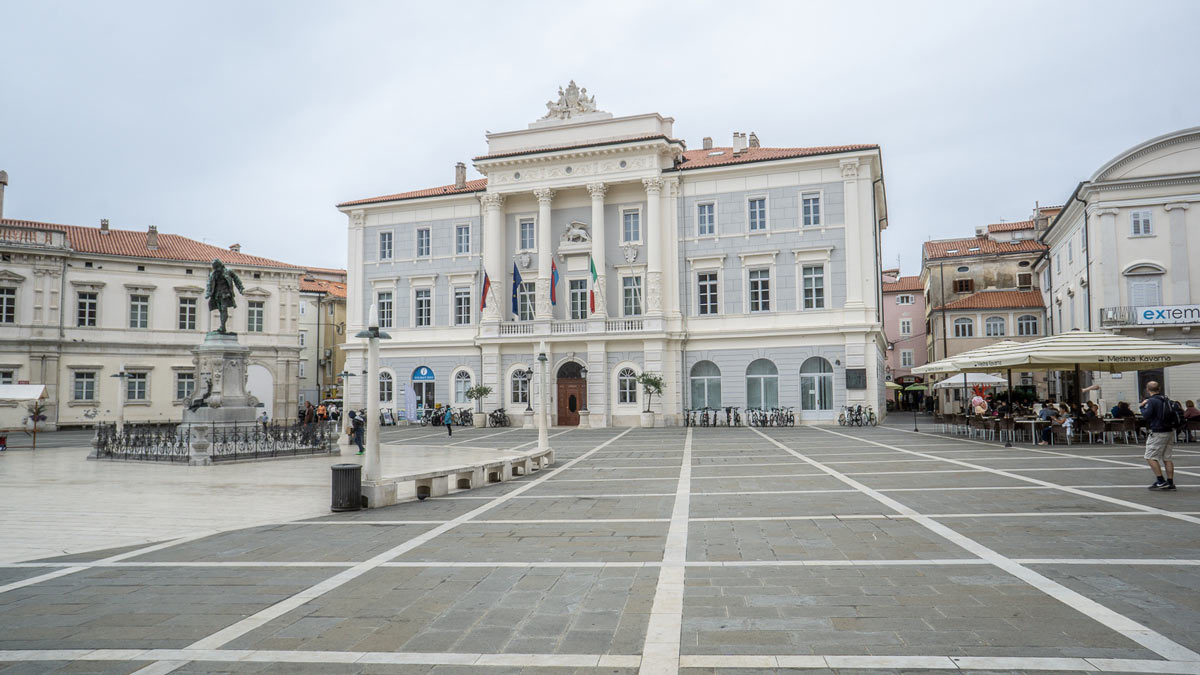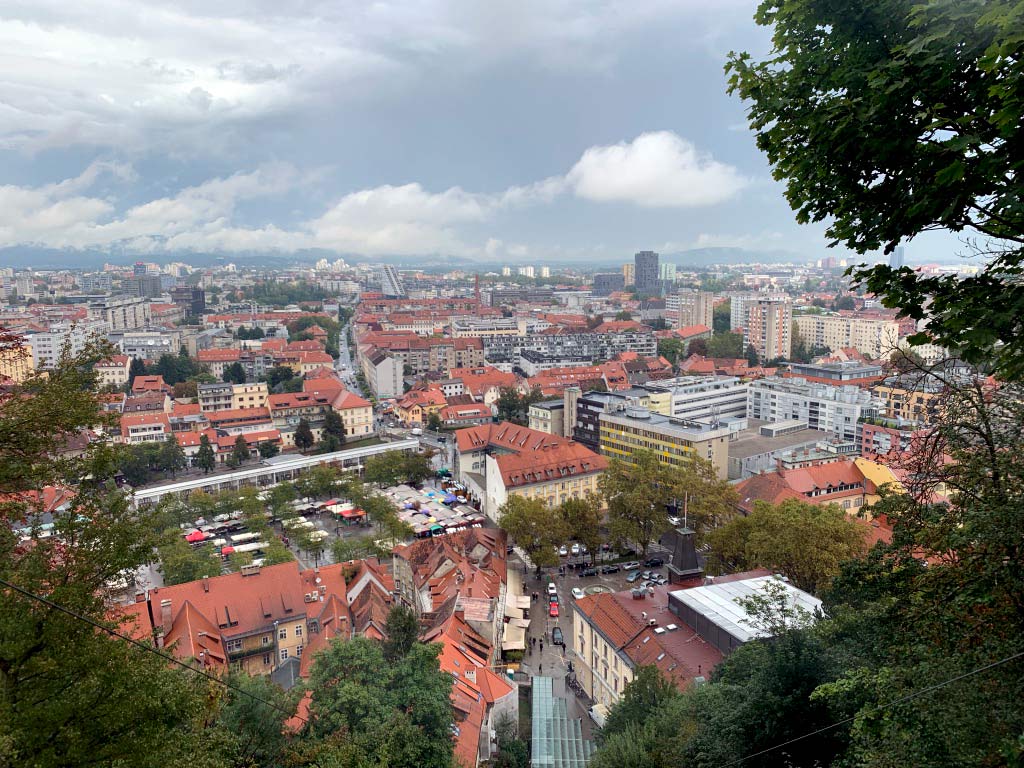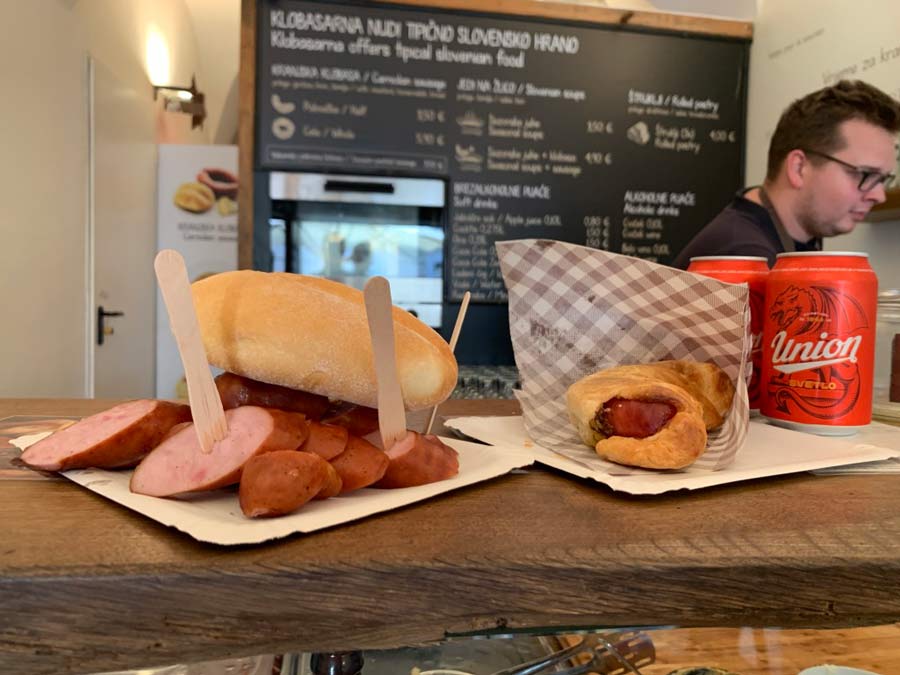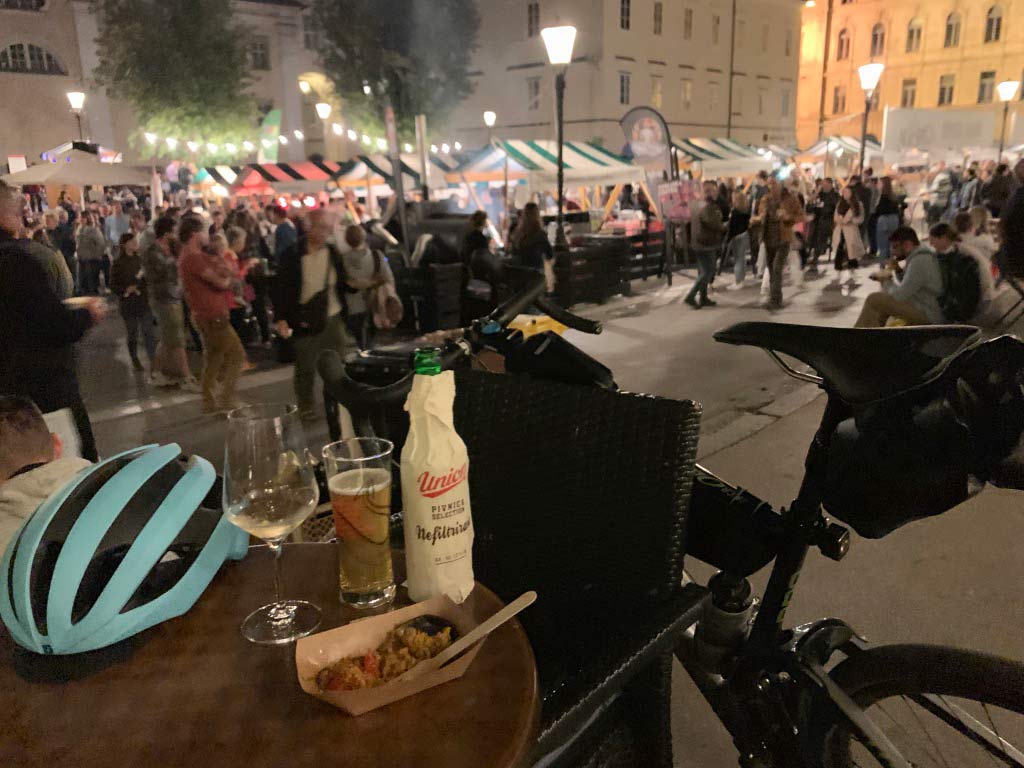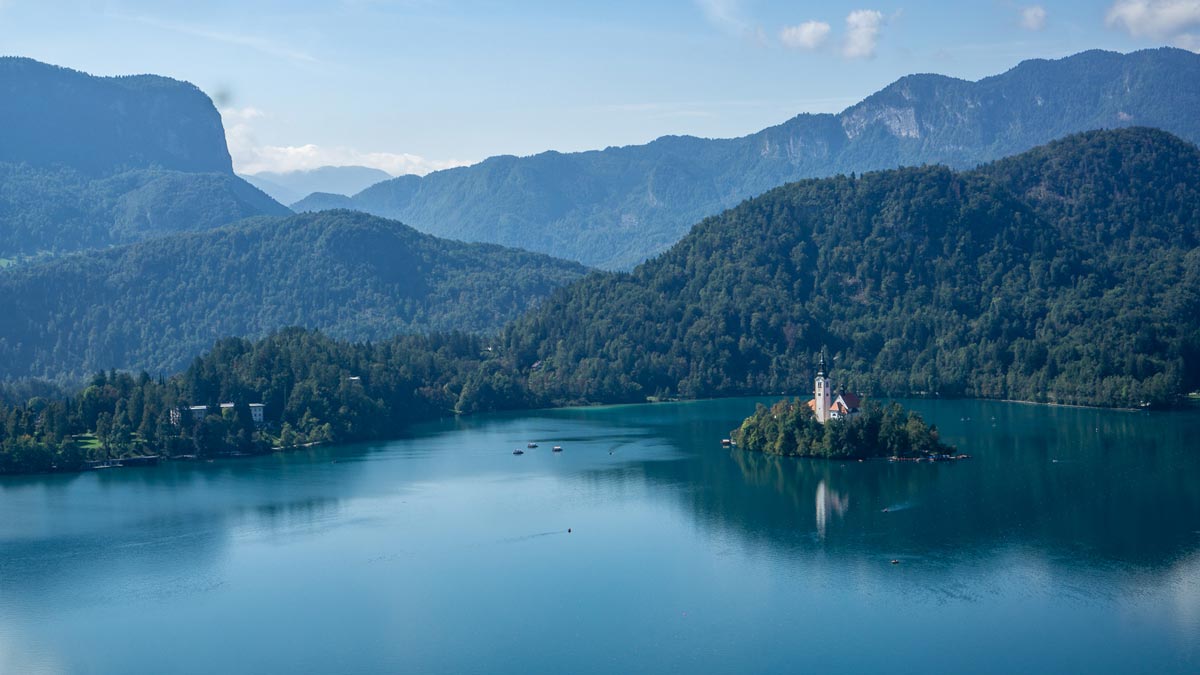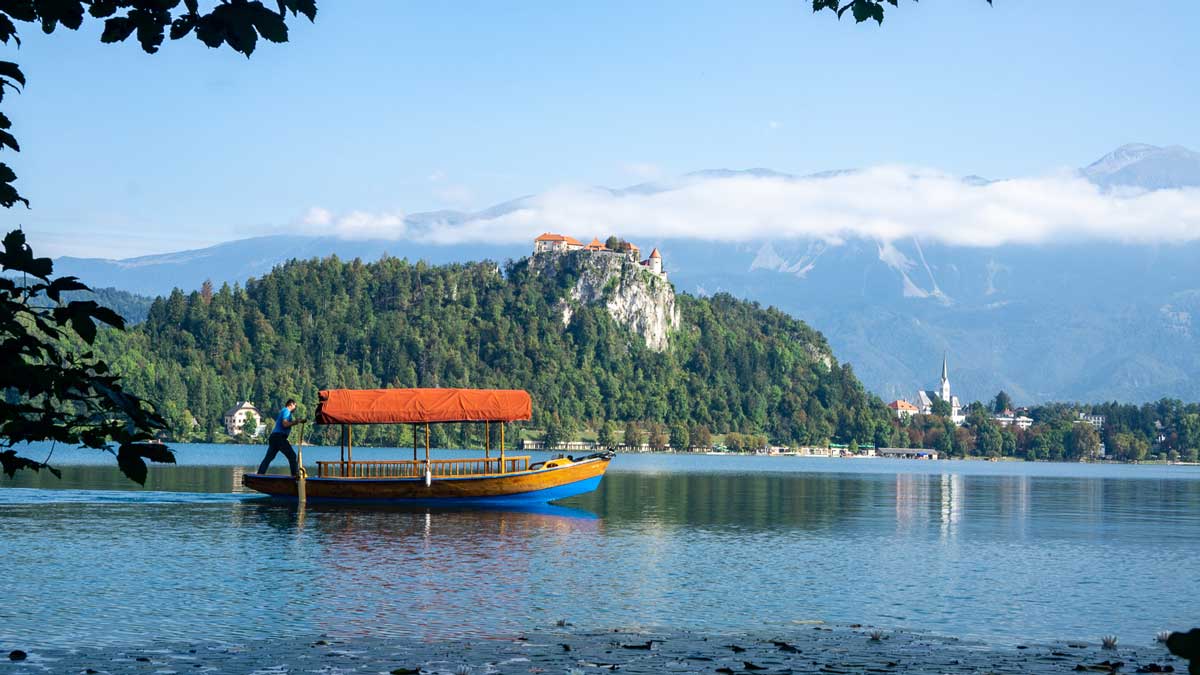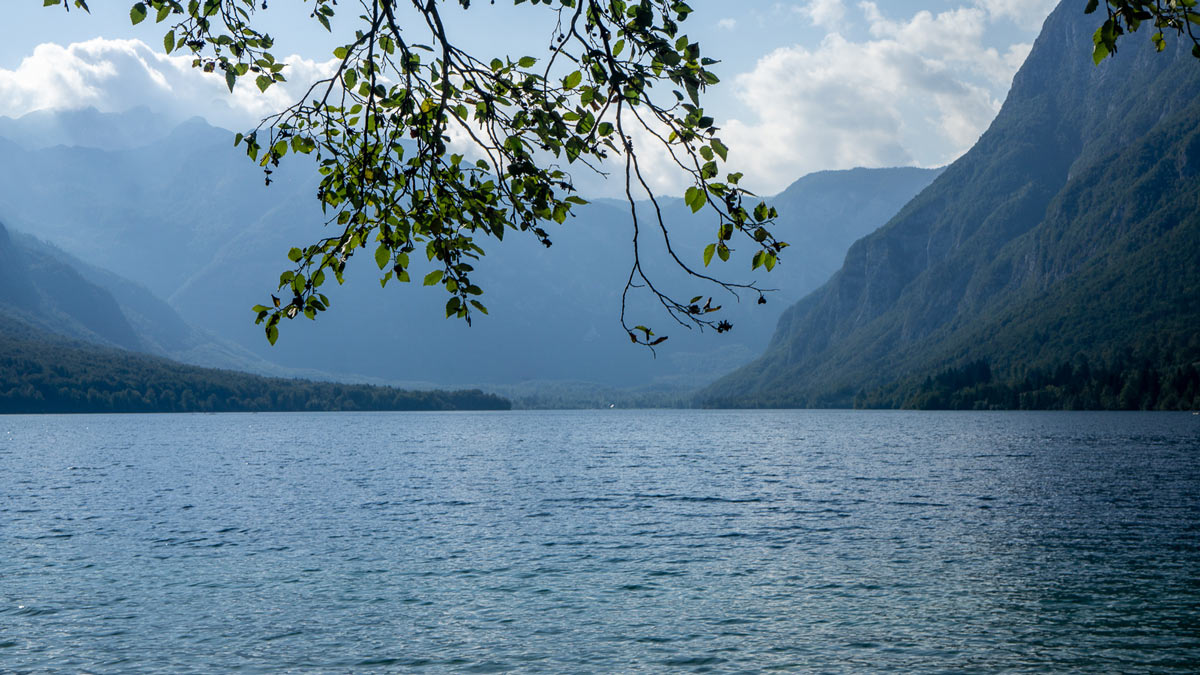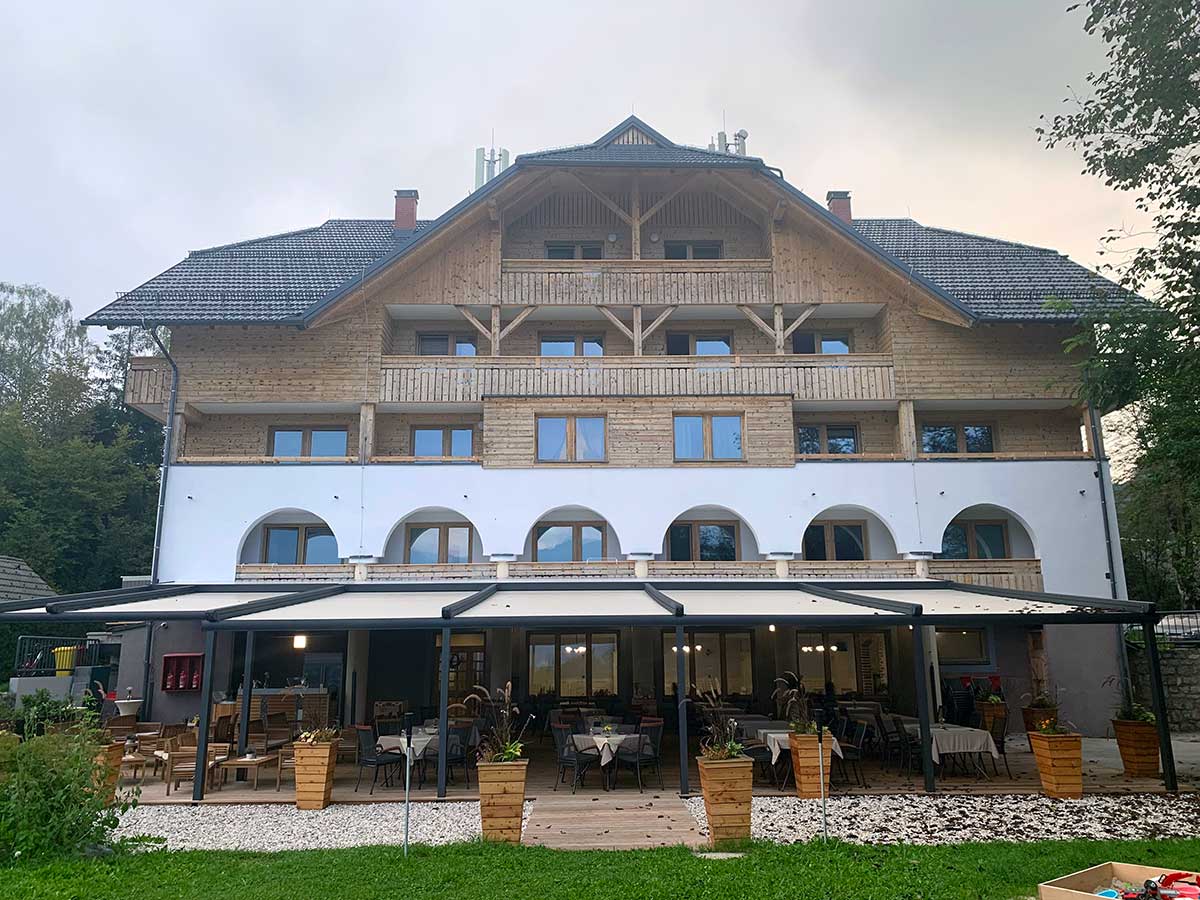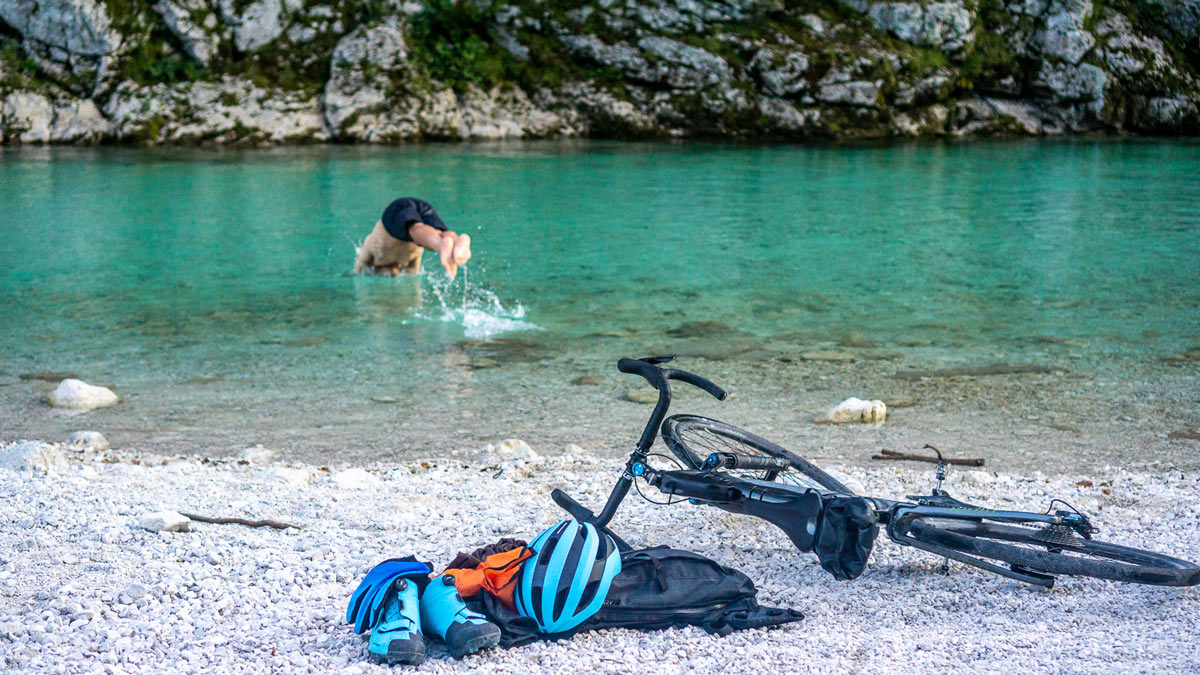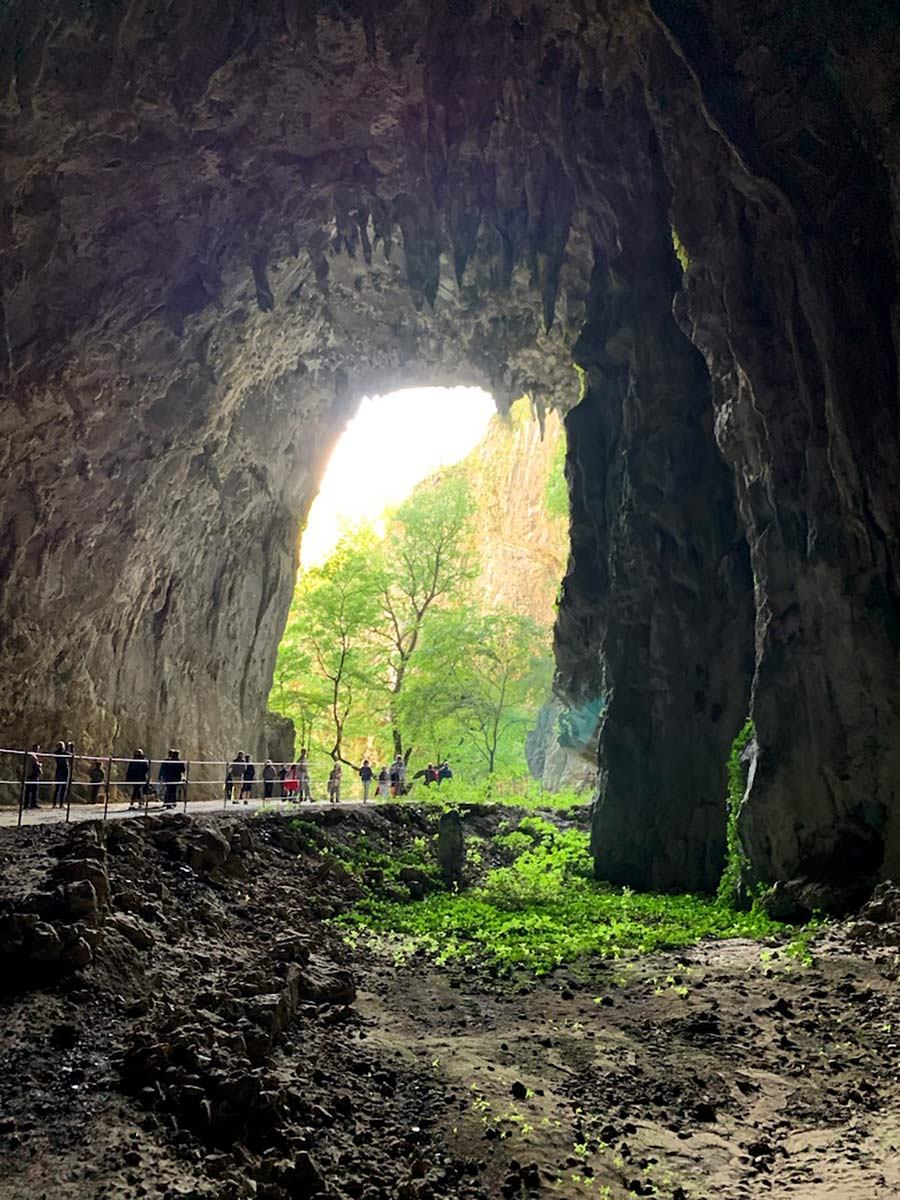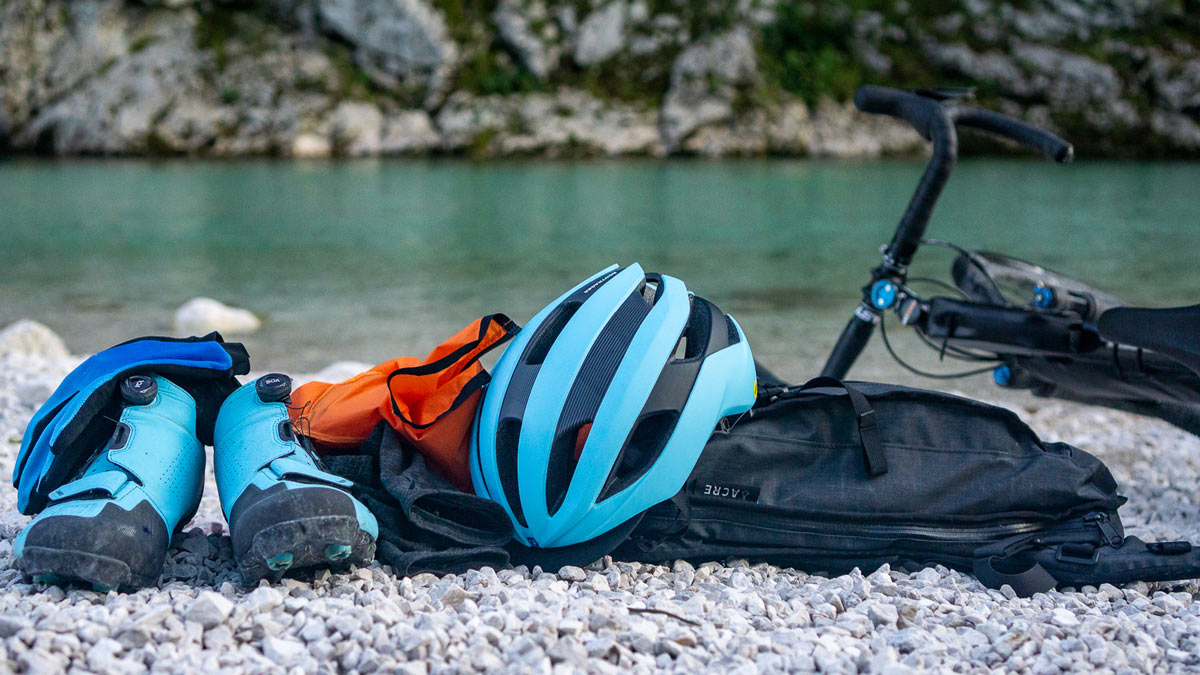When I shared I was visiting Slovenia, reactions fell into two camps. “Why Slovenia?” some friends asked through squinted eyes, trying to triangulate where exactly it was on the map. The other was an elated “Slovenia!” followed with a rush of memories and eager advice on what to see and how much I’ll enjoy it.
The reason we chose Slovenia for a gravel bike adventure was its location. Europe is rich with history and natural treasures. And the very best of it is often found at cultural intersections. When east meets west (or south), civilizations traffic in traditions. A tapestry of food, culture, and history weave together the familiar and foreign.
Sitting at the crossroads of north, south and central Europe, Slovenia embodies the best of it all. A hint of Germanic, but distinctly Balkan, the fairytale land of Slovenia grabbed our attention at every hair-pin turn, whetting our appetite for more. And Slovenia kept delivering in spades. More plates of food, more flutes of wine, more singletrack, more caves, more castles… more eye-popping scenery.
Fresh off our own “European Vacation,” we’ve highlighted the very best of what Slovenia has to offer the rider, both in and out of the saddle. Bring your bike. Bring your family. And bring your stack of memory cards. Slovenia will fill them all.
Cycling in Slovenia
Slovenia is a small country with just over 2 million people spread across 22,000 square kilometers dotted with quaint, picturesque hamlets. Even the capital Ljubljana (pronounced Loo-blee-yana or simply Loo-blah-na) has a small city vibe and an amazing cycling infrastructure. Separated bike paths and lanes are literally everywhere.
The paved main roads connecting towns are technically open to cyclists…some even being official “cycle paths”… but they’re narrow, and cars speed past at up to 100kmh.
Paved back roads post speed limits between 50-70kmh, and are more appropriate for the casual cyclist and roadies. If riding with other cyclists, be aware there’s a law limiting your peloton to no more than four in a row because it makes it too hard for cars to pass safely.
Forest roads are generally open for riding unless a land owner forbids access or they’ve been closed to protect an animal species. These gravel backroads can lead to some amazing views, but it’s hard to connect them from city to city without a little tarmac.
While road cycling reigns king in the land of castles, mountain biking is coming along. Slovenia has seven (!!!) bike parks, including one that descends through an abandoned mine along the Austrian border (Mount Peca in Mežica).
Looking to string together as many backroads as possible, we brought Niner’s updated gravel bikes. Tyler rode the new full suspension MCR 9 RDO and had some fun tackling stairwells and broken limestone trails. I was plenty comfortable on the new RLT 9 RDO, Niner’s top-shelf carbon gravel bike. Both were strapped with 700 x 40c tires – versatile enough to navigate the forest roads or pick up the pace on the tarmac.
We recommend bringing a small set of lights. Night comes quick when every turn presents a gorgeous stop-and-take-it-all-in view. Lights will help you find your way back and keep you visible to drivers. We chose to bring the Bontrager’s small but mighty Ion front and rear lights.
We’d also recommend you strap a few bags to your bike to carry your camera, a jacket, or store any souvenirs you pick up to bring back home. Roswheel bags were lightweight, reflective and waterproof for those afternoon deluge’s you often get in the Alps.
Packing the right clothes (like the mostly-Merino Wool and quick-dry shirts and shorts from Mission Workshop that we used) let you ride light and keep the stink down. Most every hotel offers breakfast, and there are so many great restaurants with very affordable food and drink that you’d be doing yourself a disservice trying to pack food on the bike.
Below we’ve highlighted the best-of-the-best for cycling in Slovenia. With some noodling over Google Earth, you could connect them all (but expect some traffic). At the bottom of this post, we’ve embedded downloadable Komoot tours of all of our rides so you can start to create your own. Or, you could get a van, like we did, to sprinkle in some touring between rides.
If you want to see everything in a hurry, the Race around Slovenia starts in Postojna and goes up Vršič pass, up and down Mangart Saddle, thru the spectacular Soča Valley, and closes the loop back to Postojna. It’s about 1200km with 30,500m of climbing. The winners crush it in about 34 hours!
Now onto the rides!
Day 1: Bled to Bohinj to Zajamniki Meadows
Google “Slovenia” and an image of Lake Bled’s island church is most likely the first result you’ll see. It’s stunningly beautiful, and worth the visit despite being one of the most popular tourist stops in the country. Rent a canoe or SUP and make your own way there before exploring the rest of the lake. Or just swim to it. Or get one of the pletna boat guides to paddle you out there.
And Bled Castle in the background? Worth seeing, too. Then hightail it out of there and head over to Bohinj for the start of an amazing ride.
Bohinj (bo-heen) is less crowded than Bled, the lake is bigger (and colder) and they have some great restaurants. Sitting at the end of the road and the toe of Triglav National Park, Bohinj Lake and the surrounding hamlets yawn out under the towering green slopes of the Julian Alps. Like most of the alpine lakes, motorboats are prohibited on the lake, so it feels just a little bit closer to nature. The best place to take in that nature is undeniably the shepherd village of Planina Zajamniki (Zī-yom-neh-kē).
To get there, follow the switchbacks out of Studor v Bohinju until you top out at Uskovnica, a green alpine pasture and backroad intersection. Take some time to fill the bidons from the faucet that spills into the cattle trough. After picking up your jaw from the stunning views of the Alps, follow the signs pointing southwest to Planina Zajamniki. Just off the gravel road ducks a smear of farm dirt, lined with hand crafted cabins sprinkled across the alpine pasture. Follow the ringing of cowbells down the valley and past the cabin porn. The best view to ogle it all is from a hill on the far side of the pasture, next to the highest cabin.
Your lungs will twinge, your legs will wobble, and your cheeks will ache from that ear-to-ear grin smacked across your face, forcing you to stop and appreciate that there is such a place on earth.
Slovenia has a number of summer Dacha villages tucked away high in its alpine pastures. Several allow you to spend the night or even get your hands dirty helping work the farms.
With enough planning and supplies, you could ride through Zajamniki and down to Jereka or even Bled and hop the train back to your hotel on the shores of Lake Bohinj. This would make for a fine afternoon loop and remove the anxiety of riding the crowded 209 back to town.
Off the bike activities
If you’re making a couple days of the area, hit up Altitude Activities for some off-the-bike adventure. Slovenia is full of climbing, hiking, paragliding, paddling and whitewater rafting options, and if you have time, they’re a good way to see more of the country. And Matejz at Altitude Activities can guide you through most any of it, or help arrange the things they don’t offer.
We booked their Via Ferrata climbing for the morning, followed by Canyoning. Via Ferrata translates to Iron Way and was developed by the Italian army to help its troops move across the sides of mountains to get supplies and people safely through war zones without being spotted on the ground. Now, those rebar-and-cable remnants have been augmented as adventure activities that provide a more approachable way to try mountain climbing. It’s still not easy, but they provide excellent coaching and all of the equipment you need.
Canyoning starts out with a hike up the side of a waterfall-carved canyon, then you work your way back down by rappelling and jumping from pool to pool, waterfall to waterfall. Combined, the two make for an exhilarating (and exhausting day), but was easily one of the most memorable parts of our trip.
Our Route
Day 2: Bovec to Mangart Saddle
The highway east out of Bovec (Bō-vetz) forks north towards Mangart (the highest rideable road in Slovenia) and east up Vršič (Ver-sētz) pass, which is the tallest mountain pass in Slovenia. Both roads were created to haul military supplies to the front during one of the heart-tearing wars (and there were many).
Connecting Bovec to the ski town of Kranska Gora, the Vršič pass climbs to just shy of 5,300 feet, and is the longer, wider and better maintained of the two. It can be ridden as part of a longer tour connecting the Alps to the Adriatic, or as an out and back from Bovec. Small jeep road variations can occasionally pull you out of traffic.

But don’t let the draw of the tallest pass stop you from tackling the dead-end road up to Mangart saddle, which we felt was the highlight ride of the trip. To get to Mangart, either take a shuttle or ride route 203 from Bovec to the bridge, 10 miles from town, where there is a marked pullout for route 902 (Strmec na Predelu). Not for the vertiginous, the seven-mile, 3,500-foot climb pulls you up a single lane road that pretzels through the mountain on the way up to the spectacular saddle. The ride starts in the trees and loops out high in the sky, ending with a view that spies out over Italy.
The road up Mangart is one lane, but traffic is light enough to enjoy the ride. Just below the summit, an alpine hut caters to alpinists, hikers and cyclists, serving up goulash and spaghetti (the hut is essentially in Italy after all). We’d whole-heartedly recommend warming up with bowl of Jota, a traditional cabbage, bean and sausage stew chased with their house-made spiced schnapps using local flowers. It lifts the spirits and energizes you for the ripping ride back down the mountain, which took us a little under 20 minutes!
Unfortunately Vršič pass was closed while we were visiting. Good news for you, they were working on it to make it better. Feeling ambitious? Indomitable athletes will tackle both Mangart and Vršič pass in a day. Which will make your stay at the Hotel Dobra Vila all the more pleasurable.
Our Route:
Day 3: Predjama Castle and Postojna Cave
For our shortest ride day, we based ourselves in Postojna (post-own-ya) at the Hotel Jama. The hotel sits adacent to the Postojna Cave, but is just a short ride away from Predjama, a small countryside village where one of the top 10-must see castles in the world lords over the valley below.
Like so many of our routes through Slovenia, a keen eye and willingness to stop and check the map leads to dirt roads running through small villages. These detours got us off the main roads, which in all honestly never felt dangerous, but more importantly provided a glimpse of local life and far more interesting scenery. The route between Predjama and Postojna is short, but full of climbing in both directions.
Off the bike activities
Predictably, Predjama castle is another of the busiest tourist spots in Slovenia. Get there early, before the busses show up, and take a guided tour for the most impact. There’s a ton of stories to be told about how it was used over eight centuries. We’ve put more info and images about these locations at the bottom of this story.
Our Route:
Day 4: Farm to Table to Singletrack on Nanos Plateau
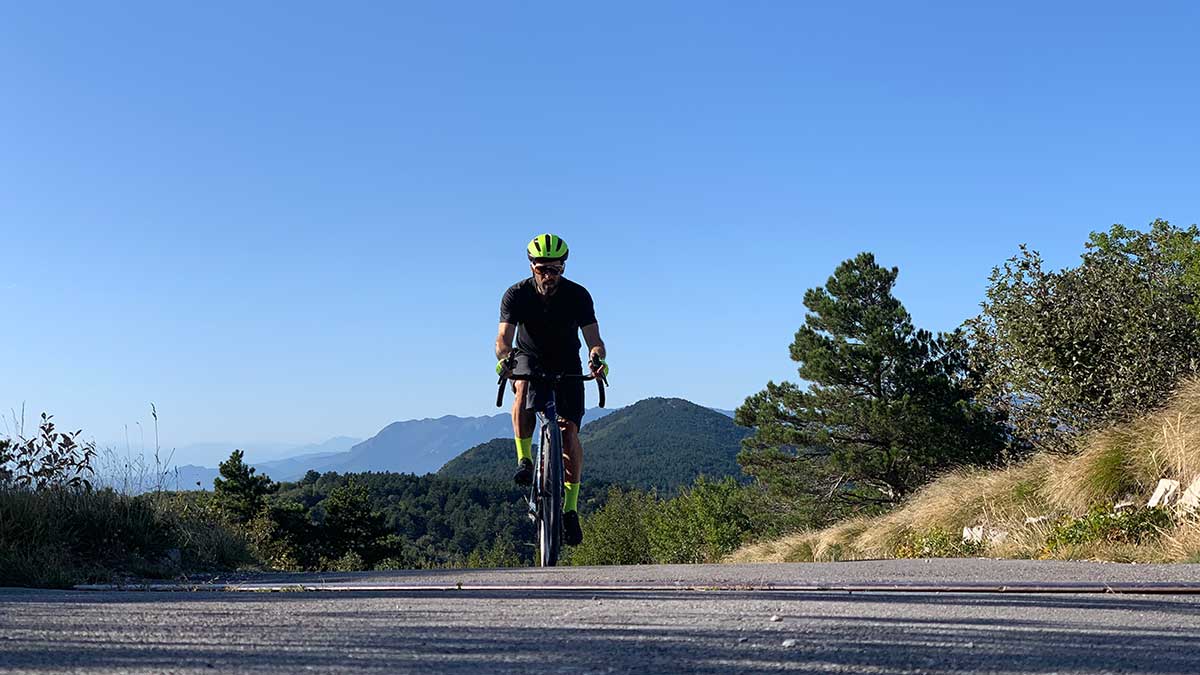
Near Postojna, and requiring a solid half-day or more to properly ride, is Vipava. The region is known for its cured meats and fine wine, and recently topped Lonely Planet’s top 10 destinations list.
On the way up to the top of the Nanos Plateau, we sampled the best of it at Turistična kmetija Abram Nanos (Tourist farm Abram at Nanos Plateau) for lunch, a farm-to-table eatery serving the best plates of cured meats we’ve ever had. The Abram Farm is open daily in summer, but is open only on weekends in the off season. Meats, wine, beer, vegetables–it’s all made on sight and is delicious. Make reservations in advance, it’s a local favorite. And they have a bear.
Let your food settle, then pedal up to the top of Nanos Plateau. It’s a gnarly climb, with stretches pitching above 11% grade for what seems like hours before it punches out onto the plateau. The dirt roads are so steep that they’re occasionally paved to prevent washing off the hill. Take a break at St. Hieronim church to catch your breath and rest the legs, where you’re rewarded with shimmering golden views of the Adriatic Sea.
KOM’s can either continue up to the summit. We dropped down the rocky trail that splintered below St. Heironim church, following it along the cliff side for even more killer views of the coast. Just when it ducks into the trees and gets a little too technical for a gravel bike, bushwhack through the grass to the road and then decide if you’ll climb back up to the farm, or have your shuttle meet you in Podnanos.
Not only will you get an amazing switchback descent (which delivers fiery sunset views if you time it right!), but you’ll finish at Pošta Slovenije, a small post office-cum-bar that has cold local beers in the cooler.
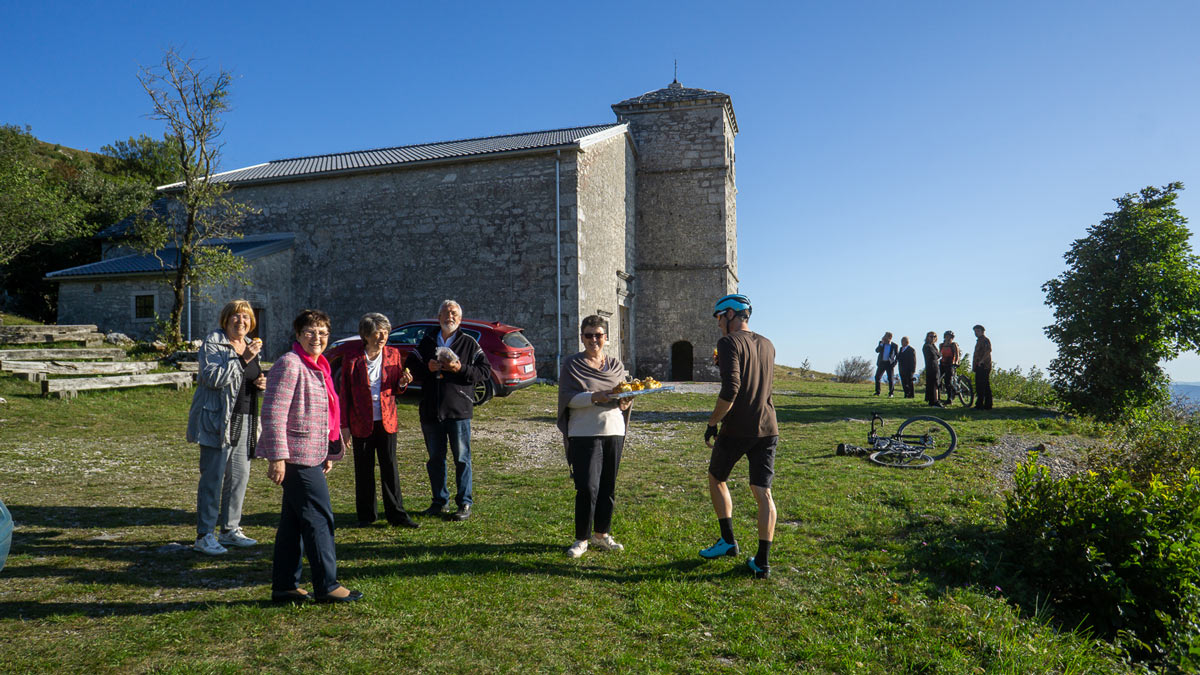
The folks in the region are extremely welcoming. Case in point: we found ourselves crashing a wedding at St. Heironim’s where the father of the bride proudly poured us each a glass of wine and the mother insisted we take a serving (or two!) of the wedding cake.
With the sun setting over the Dolomites and Adriatic, we flipped on our Bontrager Ion lights and sped back to town where we stepped into a bar for Wi-Fi to call our ride. The locals treated us like heroes, clinking beers, slapping our backs. They urged us towards the wall plastered with a world map and gave us each a push pin to mark where we were from. We celebrated Idaho and North Carolina like it was Iowa and South Carolina. The hospitality blew our minds. As did that descent.
Our Route:
Day 5: The Adriatic Coast
Within line of sight from the sea, Truške is surrounded by vineyards, making it an ideal hub for oenophiles. For those looking to earn a lunch, it’s also a half day riding distance to the coast.

We followed the roller coaster hills towards the coast, along narrow back roads lined with grape vines and olives orchards. A few steep switchbacks led us past hilltop churches and threw a few erroneous “Re-Routing” adventures courtesy of our devices. To keep the spirits high, we sampled sweet roadside figs, pulled right from the trees.
Our gravel bikes made the detours a non-issue, and we were pleasantly surprised at how much you could connect along the marked farm tractor paths, hunting trails, and dirt access roads. All of which further convinced us we could have definitely strung together a network of smaller roads and trails to make this trip entirely by bike if that were the goal.
Eventually we made it to the coast and stopped for beers in the sleepy fishing village of Seča. We spent an hour watching boats drift in and out of the bay before we continued our lazy ride into the resort town Piran. With its small red tile roof villas and lush vineyards sprawling across the seaside hills, the Venetian seaside port of Piran has a distinct Mediterranean mood.
I had a plane to catch early the following morning, so we celebrated our week together in Slovenia as one would: in Piran’s central plaza at La Bogetta dei Sopori. We sipped away the afternoon recounting the castles, the caves, the food, the amazing history, Slovenia’s friendly people, and gorgeous landscapes, all over generous plates of meat and cheese, and gnocchi topped with truffles and sea bass. And then we chased our time together with one last glass of wine, toasting “Why, Slovenia indeed!”
Oh, and the riding is pretty stellar, too.
Our route:
Our original ride plan:
Best laid plans, as they say… Originally, we had planned to ride point to point for the entire trip. Then Slovenia’s tourism board offered to provide a van and a guide, along with a few other suggested locations. The resulting mash up ended up showing us places we wouldn’t have seen on our own, while still allowing us to hit many the off-the-beaten path locations we originally wanted. That’s what we’ve documented above.
Below is our original planned route linking all of the regions laid out above, combined into one big map. This is totally doable, but you won’t see all of the things we saw. It also skips the killer riding around Ljubljana, too. Local groups host weekly gravel rides, so check with a bike shop in town. Or just look up the Pot spominov in tovarištva (Trail of Remembrance & Comradeship) for an incredible dirt loop around the entire city.
When to go & what to expect:
Wedged between the Alps and the Adriatic Sea, Slovenian summers are dry and pleasant and the winters are cold and wet. High mountain passes in the Julian Alps can be choked with snow well into April, while the temperate lowlands will remain warm (albeit wet) in winter.
Slovenia is a mineral rich country, and while it still has a strong steel industry (producing automotive parts), tourism is a close second. Throngs of European’s cross the border to Slovenia between June and August, during their summer holiday.
For a laid back visit (and if mountain passes are on your tick list), plan your stay during the shoulder seasons, with September being your best bet. The weather is fantastic, the trees begin to change colors, the air is crisp, and the traffic is light.
Where to stay, what to eat & things to do
Ljubljana
Like all cities in Slovenia, the capital city Ljubljana is small, clean, and green. It immediately reminded me of my hometown of Portland … but smaller so (and without the PDX scene). Instead of hurrying off to the hills, take the first day in Ljubljana to allow time for any lost luggage to find you and to simply decompress.
Take the time to walk around Ljubljana and grab some local flavor from Klobasarna. Be sure to try the pastry-wrapped, stuffed sausage. Then walk it off by visiting Ljubljana castle on the top of the hill and check out the view from its tower.
Ljubljana has a lively community bike rental program called the Pony. Come May, the Pony is celebrated it with Red Bull’s Goni Pony (Ride the Pony) race, where cyclist race the single speed transit bike 800 meters up the notorious Vršič Pass!
Where to stay
Reservations and general accommodation prices in Slovenia can be found on Slovenia-outdoor, Slovenia.info, and through airbnb and booking.com. We’ve listed a few of our favorites in each city below.
In Ljubljana, we stayed at the Central Hotel Ljubjlana. Chic and modern, the 7-story hotel is centrally located and a quick walk to the shopping district. A generous continental breakfast is served in the morning, local craft beer and gin are offered at the bar, and the espresso machine pours through grounds for free, 24-7.
Where to eat
Dining in Slovenia is less expensive than much of Europe. Dishes run €10 – €15. Add another €2.5 for a beer. Some of our favorite spots in Ljubljana include:
- Klobasarna
- Pop’s Place
- Hood Burger
- Figovec
- Moji Struklji (translates as “My dumplings of Slovenia”)
- Where to drink
- ReservoirDogs
- Human Fish
- Mali Grad
- Tektonic
Ljubljana outdoor market is open every day, with everything from fruit and vegetables, to flowers and crafts. On Fridays, the Old City side of the river is hopping, with a massive food tent takeover offering all types of local foods and drinks.
Bled
Even if you know nothing about Slovenia, spend any amount of time on Instagram and you’ve probably scrolled past the spectacular church island on two kilometer-long Lake Bled.
To visit the island’s church, catch a ride on one of the pletnas, a traditional rowboat who’s oarsman proudly pilot daily to and from the island. Tickets can be purchased at the Information Center.
Brought your trunks? Hop in the lake and swim to Bled Island (or rent an SUP). While swimming is permitted in Bled and Bohinj, it’s prohibited in lakes inside the National Parks.
For a great view of the town, take a drive (or ride) up to Bled Castle. Surrounded by the Alps, the views of the lake are spectacular and the prehistoric history shared in the museum is super cool.
Where to stay
Bled has dozens of hotels to choose from for $100-$150 a night. If you want to camp, Sobec is a huge campground east of Bled.
Bohinj
Lake Bled gets all the love. But as our guide shared with us, “Bled is the place to be seen.” If you really want to see the Julian Alps, go to Bled, tour the church. But then immediately head west to the nearby lake Bohinj. Sitting at the foot of Triglav National Park, Bohinj seems a world away from Bled.
Food in Bohinj is very affordable, more so than if you stayed directly in Bled, but Bohinj can also be very crowded in summer, during the European summer holiday.
Where to stay
We’d recommend staying at the Hotel Triglav (@triglavbohinj). It’s brand new, with spacious rooms–some with kitchenettes–and if you decide to eat at the hotel, they’ll fill your gills with fantastic food at a reasonable price. The hotel is a short walk to the lake where you can swim, hike, ride or even take an electric motorboat to the other side of the lake, launching into the soul of the park for far-flung adventures.
If you traveled without a bike, Hotel Triglav rents out a small fleet of mountain bikes for €15 per day. E-bikes can be rented for €45 per day.
Where to eat
Swing by Gostilnica Štrudl for traditional soups. Mountain hut restaurants serve up fantastic fare, but some can be very commercial. You can hike to them from the lake side, or take the ferry or local bus shuttles to get to different trailheads. The Hotel Triglav also has a full breakfast and serves fantastic local fare for dinner.
Bovec
The river-rat town of Bovec sits on the shores of the toothpaste-blue Soča river. Close to the mountains, Bovec is homebase for Slovenian adrenaline sports. Rafting? Check. Skiing? Check. Fly fishing? Check. Tallest road climb in Slovenia? Check. If the outdoors are calling, it’s like from an undisclosed location in Bovec.
Where to Stay
Hotel Dobra Vila. The voguish repurposed telecommunications building numbers each room with notable regional number. Room 136 is the length in kilometers of the Soča River, which runs through town. On the main level, the in-house restaurant serves up locally sourced foods paired with regional pours all under a touch of nostalgia.
Hotel Boka, the other recommended hotel in the valley, is a few klics down the road. Perched above what looks like a dry river bed, come spring, that bed of rock boils violently with spill-off from Boka Falls as it flows past the hotel. What steals the show, is the tranquil Soča River. The light, the bedrock, the purity of the water, nobody is quite sure what makes the Soča flow in a brilliant crystal blue. But under an alpine glow, it’s about as surreal a place you’ll find on earth.
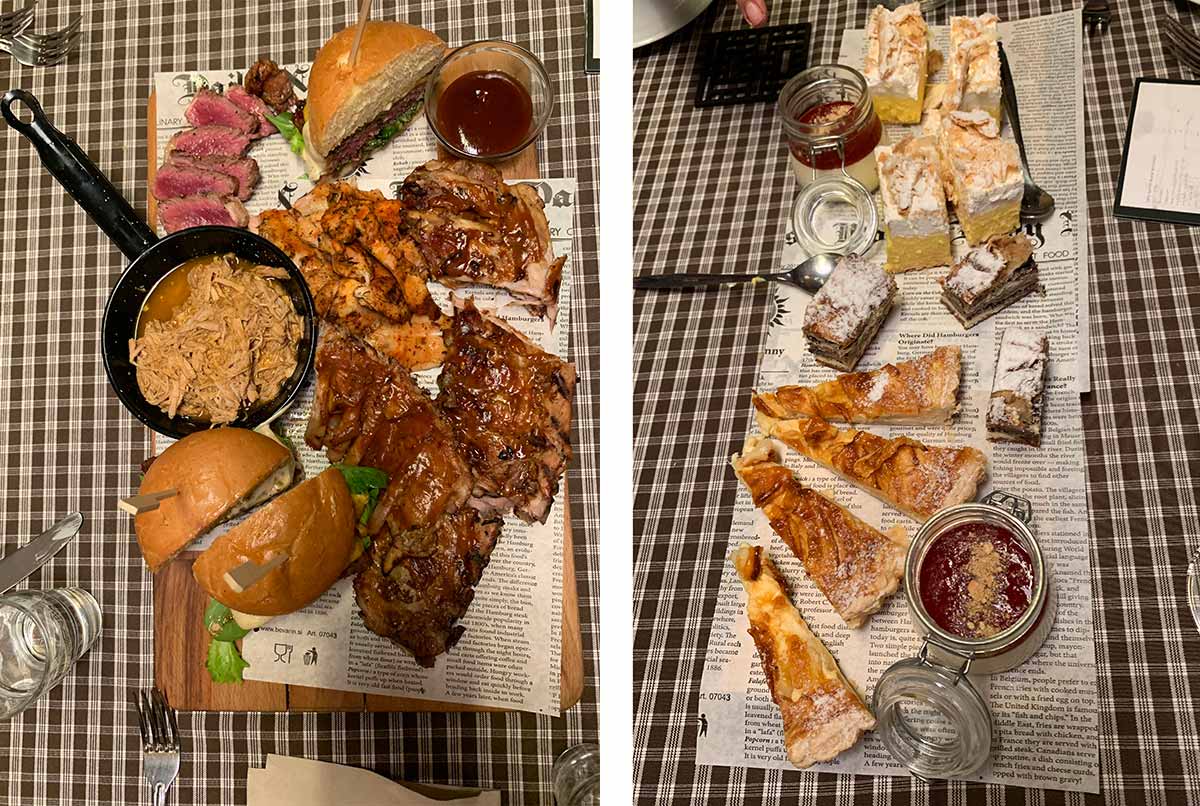
Hotel Boka proudly serves up local meat, aged, cured, barbecued or however you like it. A carnivore’s dream, the food is delicious and served by a knowledgeable staff, all under a magnificent palette of nature you won’t likely see anywhere else.
Postojna, Predjama & Vipava Valley
Interested in castles? Maybe caves? Maybe castles in caves? Postojna is the ‘county seat’ for the region and out-of-the-saddle options abound. Start with a tour to the Predjama castle. Started in the 12th century in the mouth of a cave, the Predjama Castle literally hangs from the cave wall and was one of our favorite tours. Get there early and arrange a guide to appreciate the story behind fantastic Predjama.
Slovenia is particularly known for its elaborate cave network. And on the other side of town hides the Postojna Cave system, one of the largest largest cave networks in Europe and the largest you can explore without special permission.
The cave is so immense that you have to take a train into the guts of it all, and then you walk another 5K through a labyrinth of columns, stalagmites, and stalactites. Inside the cave hang chandeliers over a stadium concert hall to host unique social events.
Just outside of town hides the Skojan cave, which is a UNESCO World Heritage Site. The walk down through the cave could have easily inspired Tolkein’s dwarf kingdom. Following a dimly lit path that courses through the cave above the subterranean river, you’ll spy tunnels and catwalks built by early cave explorers. While the cave is an amazing experience, the exit is just as fantastic. Be sure to take a detour over to the elevator for a fantastic view of the cauldron.
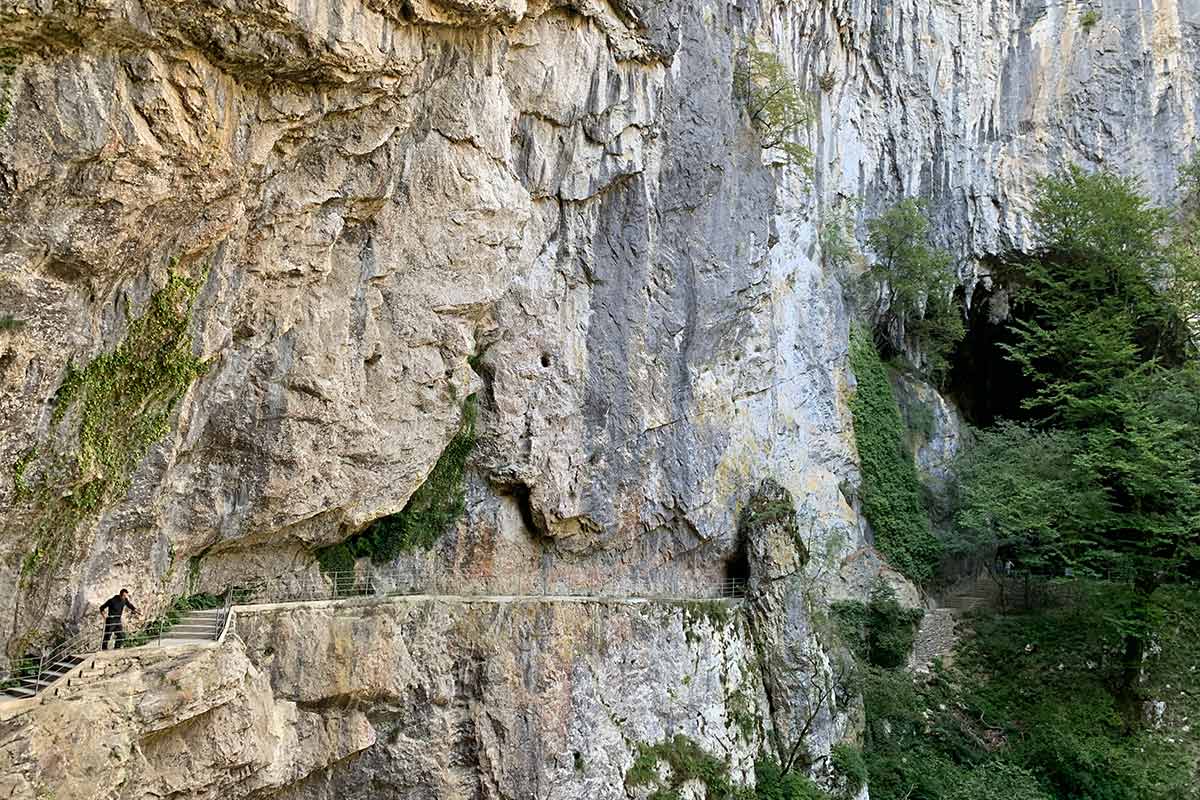
Where to stay
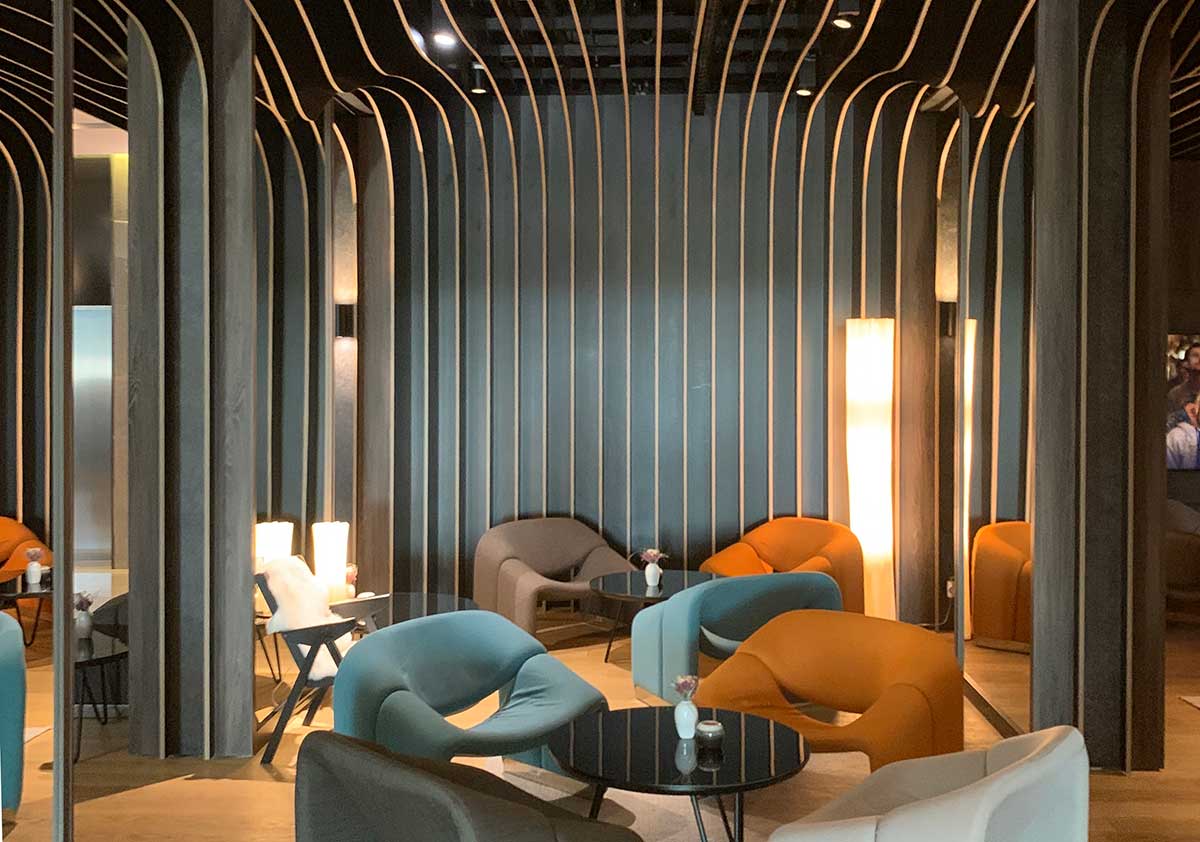
There are lots of options to stay in Postonja, but the very best might be Hotel Jama. The high-end hotel hints of a James Bond film set. Not surprising, its connection to Yugoslavian spy history is still being revealed. Hotel Jama sits adjacent to the entrance of the Postonja cave and a short distance to the Nanos Plateau.
If you want to make home base near the Nanos Plateau, (and we’d recommend you consider it), Abrams Farm rents rooms by the night for backpackers and travelers. An unexpected guest made the farm its home some 25 years ago. A brown bear cub abandoned by its mother befriended the original owner and now is a permanent resident.
If staying in Vipava (the main town below the Nanos Plateau), a walking path leads to castle ruins that you can explore. The region has miles of family-friendly cycling paths, too.
What to eat
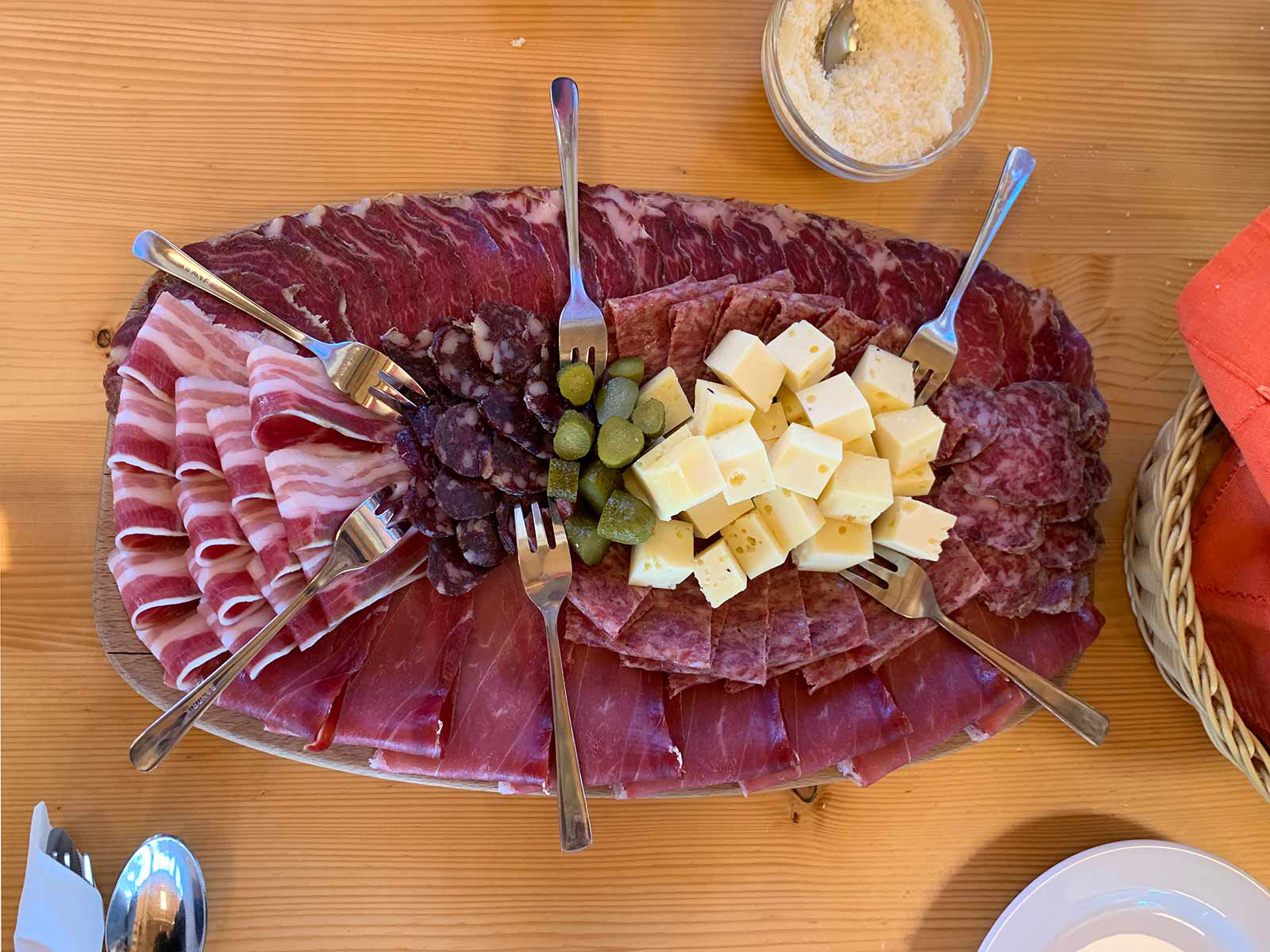
The Nanos Plateau sits adjacent to Vipava Valley, which sees winds up to 100+ km/h. You’ll notice some homes have stacked rocks on the roof to hold down the tiles from the strong gusts of winds that blow past the plateau. You couldn’t tell from the dense tree and green coverage, but the region is a comparatively dry part of Slovenia.
The dry weather and fertile soil makes it ideal for vineyards, which produce a wide variety of good wines. If you visit the region, pick up a bottle of Zelen (a white wine). And if you like meats, be sure to sample the regions dried hams. They are fantastic.
Truške and the Adriatic coast
After our adventure on the Nanos Plateau, we drove to Truške, a small village surrounded by fertile wine country, and would be an ideal location for wine enthusiasts who want to be close-ish to the coast.
Where to stay
We spent the night at Slovenian Istria, an apartment style hotel that manages a working farm typically known as an Istrian House. Many rooms have a kitchenette, but local flavors are served by the host for breakfast and dinner in the dining room.
Where to eat
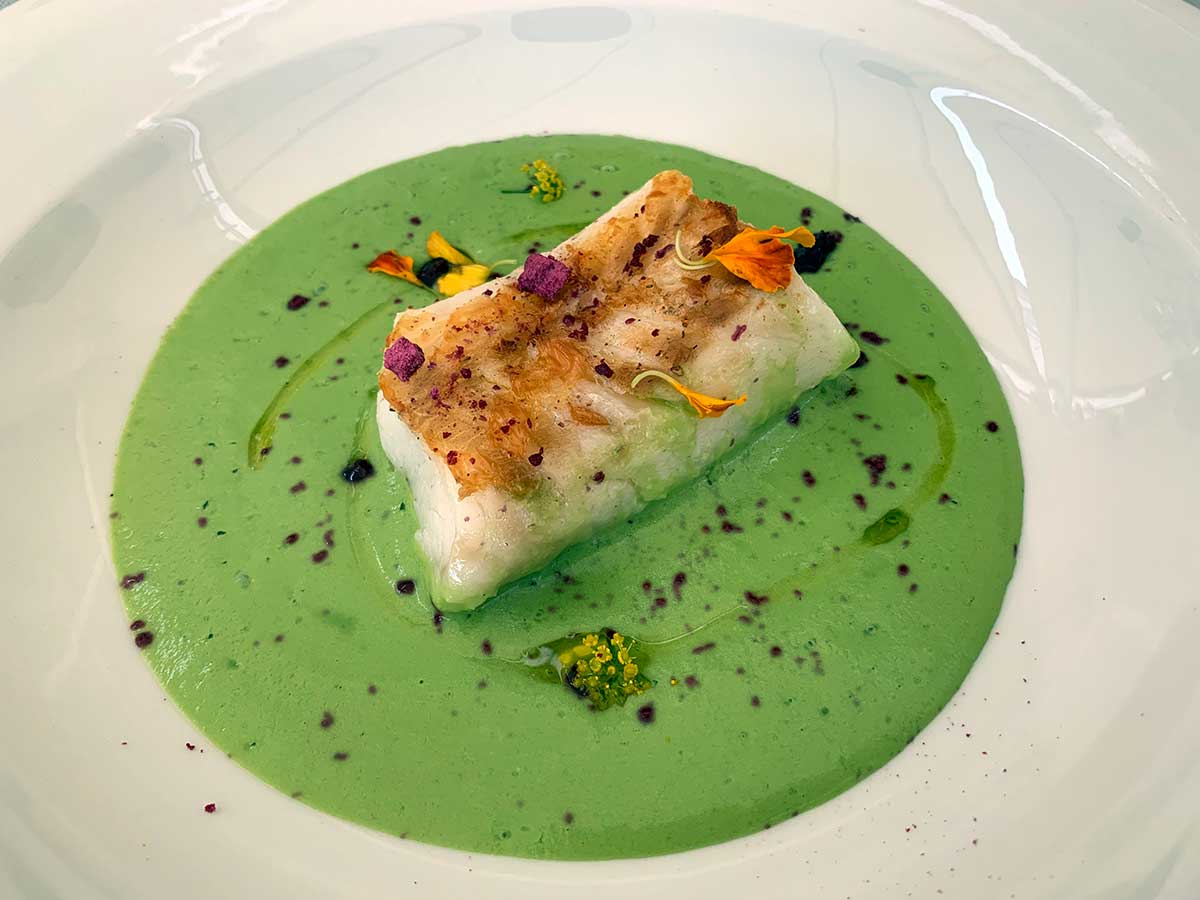
Like most coastal towns, the food scene is fresh and inspired by the sea. Eateries abound in the small towns, but perhaps our favorite was at the end of the ride in Piran. A two-hour ferry ride from Venice, the food is decidedly Italian. If you’re on the coast, we’d recommend eating at La Bogetta dei Sopori.
How to get to Slovenia:
All international flights to Slovenia travel through Ljubljana, with no less than two connections from the States (it took me three connections from Idaho). The airport is small and friendly and we found our bags and bikes within minutes.
Adria Airways, the main carrier in Slovenia, is particularly forgiving with oversized bags. So bike bags will typically sail through the check-in process. But if your bag tips the scales over 25kg, you’ll have to pay a €100 weight fee. The fee process is also disjointed. Oversize fees are collected in another office, pulling you out of the check-in line. You then need to show your receipt back in the first line. That is to say, if you’re in a rush, pack light.
The airport sits some 15 miles north of town. Arrange for a shuttle to bring you into town where you can rent a van or catch a train north to Bled.
Need to know:
Slovenia is part of the European Union, so traveling is as simple as bringing a valid passport. Most places take credit cards, though smaller towns will only take cash. We stored an extra €50 in the phone case for ‘just in case’ and ended up using it to buy beers.
The local language is Slovene, but Italian and Hungarian are spoken closer to the borders. Many of the locals speak English, especially in the tourist areas. Millennials often speak it amongst themselves, too.
Roaming Wi-Fi connection was spotty with our Verizon Travel Pass. At hotels, Wi-Fi was free and reliable. About half of the hotel Wi-Fi’s were password protected.
Camping is restricted to designated campsites only. You will be ticketed for pulling over and car camping or pitching a tent outside designated areas. Swimming is prohibited in the national park lakes.
Choosing the right gear:
This Where to Ride story was made possible through the help of sponsors. Slovenia’s tourism board was the biggest, covering our flights, meals and lodging. They also provided a guide, which helped us find the right mix of things we thought we wanted to do, and things that they knew we should do even though they weren’t on our list. And we really appreciated their flexibility in planning because the end result was something different than any other “fam” trip that typical media outlets are treated to. So what you read and watched above is truly an ideal mix of the tourist spots you need to see, plus out-of-the-way riding spots that most people will never find. Slovenia, you blew our minds and ruined our appetite for American pork. We look forward to coming back soon.
Brands that made the cut
What made these brands’ support so special is that there was no agenda. We got to choose the products we thought would work best for the trip, they didn’t push anything on us. We’ll be posting full reviews on everything in the coming weeks and adding links here. Fortunately, everything performed well, with a few standouts and surprises. If you’re planning your own multi-day (or multi-week) trip, check these brands out:
Niner Bikes. We brought over Niner’s new gravel bike lineup. Tyler rode the new full suspension MCR 9 RDO and had some fun tackling stairwells and broken limestone trails. I was plenty comfortable on the RLT 9 RDO, Niner’s top-shelf rigid carbon gravel bike. Both were strapped with 700 x 40c tires – versatile enough to navigate the forest roads or pick up the pace on the tarmac. (Read the Reviews – MCR and RLT)
Mission Workshop. Ride abroad without looking like a tourist. Mission Workshop’s neutral tones stand out in a world of bright cycling kits, keeping you under the radar when touring. We chose a handful of garments made from merino wool. Merino has natural anti-microbial qualities and block UV rays. Bonus, they look equally good out of the saddle. (Read the Reviews)
Bontrager. Form that meets function, the WaveCell helmet is a beautiful lid that cools, protects and wears better than anything I’ve tried on the market. The bright colors helped add visibility when you want it most. Tyler rode the Velocis MIPS and loved its lighter weight and integrated soft visor.
Our route mixed a little hiking and city walking so we chose a stiffer mountain bike shoe for traction and comfort. The Cambion closes around the foot with an offset Boa system lacing that releases wide open with a tug on the dial. Push the dial back and a few quick turns equalizes the fit.
Time seems to slip away when you are having fun in the saddle. Find your way home and stay seen by drivers when scrambling back from the day that ran into night with Bontrager’s Ion light collection. These little numbers were quick to recharge and virtually disappeared in the frame bag when we didn’t need them. (Read the Reviews)
HT Components. The SPD-style pedals were easy to adjust, quick to enter, and held our feet in place over the rougher stuff.
Silca Velo. If you ride carbon, sooner or later you learn the importance of torque. A loose fitting can be a pain. Too tight, and it can be disastrous. 70% of all damage to carbon frames and components happens when an overzealous wrenching bears down on a fitting. If you’re making adjustments in the field, SlLCA’s T-Ratchet and Ti-Torque kit are a handsome way to do so with accuracy. Their carbon bottle cages are pretty sweet, too. (Read the Reviews)
Roswheel Bags. Roswheel’s road series is constructed of TPU coated nylon, welded together with roll tight clips for waterproofness, and strap to the frame with durable elastic bands. Lightweight and aerodynamic, all zippers are rubberized, keeping water from soaking through the bags and into the load. And they’ll fit most any bike. (Read the Reviews)
